太奇2014保过班阅读精读资料——基础篇(张兵博士编写)
- 格式:pdf
- 大小:586.18 KB
- 文档页数:44
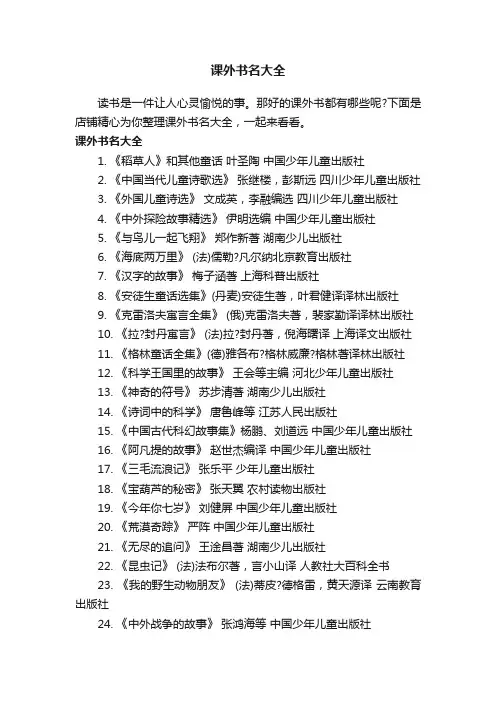
课外书名大全读书是一件让人心灵愉悦的事。
那好的课外书都有哪些呢?下面是店铺精心为你整理课外书名大全,一起来看看。
课外书名大全1. 《稻草人》和其他童话叶圣陶中国少年儿童出版社2. 《中国当代儿童诗歌选》张继楼,彭斯远四川少年儿童出版社3. 《外国儿童诗选》文成英,李融编选四川少年儿童出版社4. 《中外探险故事精选》伊明选编中国少年儿童出版社5. 《与鸟儿一起飞翔》郑作新著湖南少儿出版社6. 《海底两万里》 (法)儒勒?凡尔纳北京教育出版社7. 《汉字的故事》梅子涵著上海科普出版社8. 《安徒生童话选集》(丹麦)安徒生著,叶君健译译林出版社9. 《克雷洛夫寓言全集》 (俄)克雷洛夫著,裴家勤译译林出版社10. 《拉?封丹寓言》 (法)拉?封丹著,倪海曙译上海译文出版社11. 《格林童话全集》(德)雅各布?格林威廉?格林著译林出版社12. 《科学王国里的故事》王会等主编河北少年儿童出版社13. 《神奇的符号》苏步清著湖南少儿出版社14. 《诗词中的科学》唐鲁峰等江苏人民出版社15. 《中国古代科幻故事集》杨鹏、刘道远中国少年儿童出版社16. 《阿凡提的故事》赵世杰编译中国少年儿童出版社17. 《三毛流浪记》张乐平少年儿童出版社18. 《宝葫芦的秘密》张天翼农村读物出版社19. 《今年你七岁》刘健屏中国少年儿童出版社20. 《荒漠奇踪》严阵中国少年儿童出版社21. 《无尽的追问》王淦昌著湖南少儿出版社22. 《昆虫记》 (法)法布尔著,言小山译人教社大百科全书23. 《我的野生动物朋友》 (法)蒂皮?德格雷,黄天源译云南教育出版社24. 《中外战争的故事》张鸿海等中国少年儿童出版社25. 《做人与做事》卢勤接力出版社26. 《草房子》曹文轩江苏少年儿童出版社27. 《中国古代寓言故事》邶笪钟编写北京人民文学出版社28. 《中外神话传说》田新利选编北京人民文学出版社29. 《十万个为什么》卢嘉锡主编少年儿童出版社课外必读书名大全1. 《悠长的岁月》贾兰坡著湖南少儿出版社2. 《鲁滨逊飘流记》 (英)笛福著,王泉根译北京少年儿童出版社3. 《魔法师的帽子》 (芬)杨松著,任溶溶译纺织工业出版社4. 《金银岛》 (英)史蒂文生著,单蓓蕾译北京出版社5. 《吹牛大王奇游记》(德)埃?拉斯伯刘浩译少年儿童出版社6. 《淘气包艾米尔》(瑞典)阿?林格伦著,高锋红译中国少儿出版社7. 《童年》 (俄)高尔基著,上海译文出版社8. 《做一个快乐的少年人》邓碧霞译三联书店9. 《写给小读者》晓玲玎当新疆青少年出版社10. 《圣经神话故事》陈静选编中国少年儿童出版社11. 《严文井童话选》严文井四川少年儿童出版社12. 《普希金童话》 (俄)普希金著,亢甫,正成译浙江少年儿童出版社13. 《王尔德童话》 (英)王尔德著,唐讪辉译中国连环画出版社14. 《中外动物故事选》伊明选编中国少儿出版社15. 《中外经典科普故事》伍钚编中国少年儿童出版社]16. 《中外网络故事》伍钚编中国少年儿童出版社17. 《科学改变人类生活的个瞬间》路甬祥主编浙江少儿出版社18. 《水陆两栖人》(苏)阿历山大?别利亚耶夫,善诚译科学普及出版社19. 《中外艺术家的故事》江钥含编中国少年儿童出版社20. 《国际知识问答》中国少年儿童出版社编中国少年儿童出版社21. 《上下五千年》林汉达曹余章著上海少年儿童出版社22. 《马燕日记:一个感动世界的现代童话》 (法)韩石华夏出版社23. 《中华经典诵读本》徐含之选编苏州大学出版社24. 《漂亮老师和坏小子》杨红樱作家出版社25. 《幻城》郭敬明春风文艺出版社26. 《第三军团》张之路中国少年儿童出版社27. 《巫师的沉船》班马世纪出版社28. 《糊涂大头鬼》管家琪浙江少儿出版社29. 《木偶奇遇记》 (意)卡洛?科洛迪著,杨建民译上海科技教育版社30. 《格列佛游记》 (英)乔纳森?斯威夫特著,杨吴成译人教、译林版31. 《福尔摩斯探案全集》 (英)柯南道尔,丁锦华译,远流公司年32. 《顽皮捣蛋鬼》 (德)威廉.布什湖北少儿出版社33. 《七彩的分光》王大珩著湖南少儿出版社初中课外书名大全1. 《四书》2. 《易经》3. 《书经》4. 《诗经》5. 《楚辞》刘向辑6. 《文选》萧统编7. 《李太白集》李白著8. 《杜工部集》杜甫著9. 《韩昌黎集》韩愈著10. 《柳河东集》柳宗元著11. 《白香山集》白居易著12. 《礼记》戴圣编13. 《左传》左丘明著14. 《老子》老聃著15. 《墨子》墨翟著16. 《庄子》庄周著17. 《荀子》荀况著18. 《韩非子》韩非著19. 《战国策》20. 《史记》司马迁著21. 《汉书》班固著22. 《后汉书》范晔著23. 《三国志》陈寿著24. 《资治通鉴》(或《通鉴纪事本末》) 司马光著25. 《宋元明史记事本末》初中课外书:汉书简介继司马迁撰写《史记》之后,班固撰写了《汉书》。
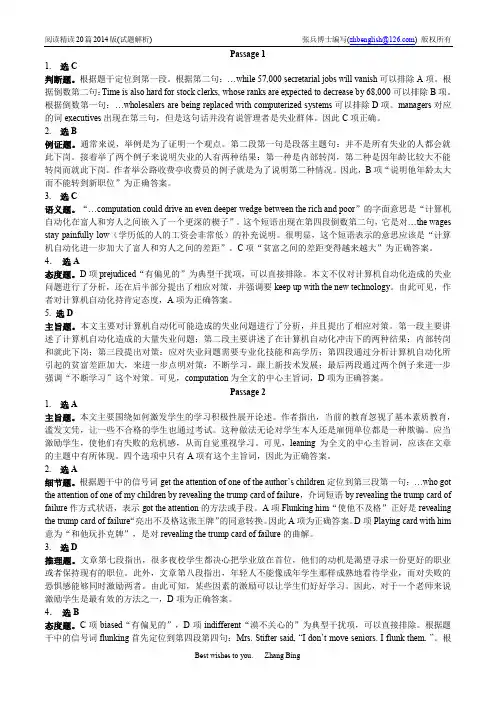
Passage 11. 选C判断题。
根据题干定位到第一段。
根据第二句:…while 57,000 secretarial jobs will vanish可以排除A项。
根据倒数第二句:Time is also hard for stock clerks, whose ranks are expected to decrease by 68,000可以排除B项。
根据倒数第一句:…wholesalers are being replaced with computerized systems可以排除D项。
managers对应的词executives出现在第三句,但是这句话并没有说管理者是失业群体。
因此C项正确。
2. 选B例证题。
通常来说,举例是为了证明一个观点。
第二段第一句是段落主题句:并不是所有失业的人都会就此下岗。
接着举了两个例子来说明失业的人有两种结果:第一种是内部转岗,第二种是因年龄比较大不能转岗而就此下岗。
作者举公路收费亭收费员的例子就是为了说明第二种情况。
因此,B项“说明他年龄太大而不能转到新职位”为正确答案。
3. 选C语义题。
“…computation could drive an even deeper wedge between the rich and poor”的字面意思是“计算机自动化在富人和穷人之间嵌入了一个更深的楔子”。
这个短语出现在第四段倒数第二句,它是对…the wages stay painfully low(学历低的人的工资会非常低)的补充说明。
很明显,这个短语表示的意思应该是“计算机自动化进一步加大了富人和穷人之间的差距”。
C项“贫富之间的差距变得越来越大”为正确答案。
4.选A态度题。
D项prejudiced“有偏见的”为典型干扰项,可以直接排除。
本文不仅对计算机自动化造成的失业问题进行了分析,还在后半部分提出了相应对策,并强调要keep up with the new technology。
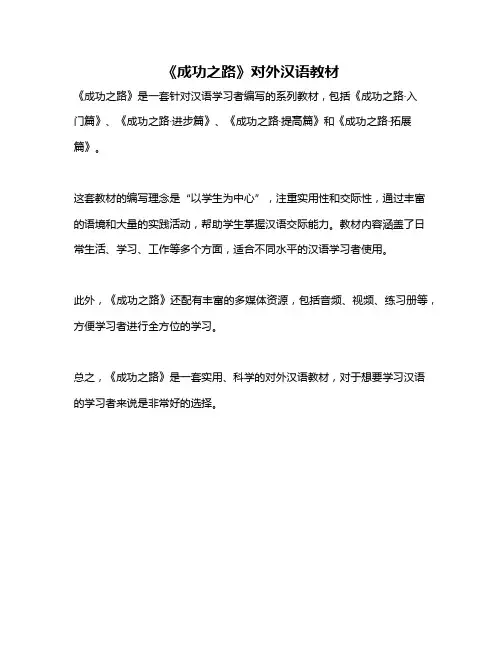
《成功之路》对外汉语教材
《成功之路》是一套针对汉语学习者编写的系列教材,包括《成功之路·入
门篇》、《成功之路·进步篇》、《成功之路·提高篇》和《成功之路·拓展篇》。
这套教材的编写理念是“以学生为中心”,注重实用性和交际性,通过丰富的语境和大量的实践活动,帮助学生掌握汉语交际能力。
教材内容涵盖了日常生活、学习、工作等多个方面,适合不同水平的汉语学习者使用。
此外,《成功之路》还配有丰富的多媒体资源,包括音频、视频、练习册等,方便学习者进行全方位的学习。
总之,《成功之路》是一套实用、科学的对外汉语教材,对于想要学习汉语的学习者来说是非常好的选择。
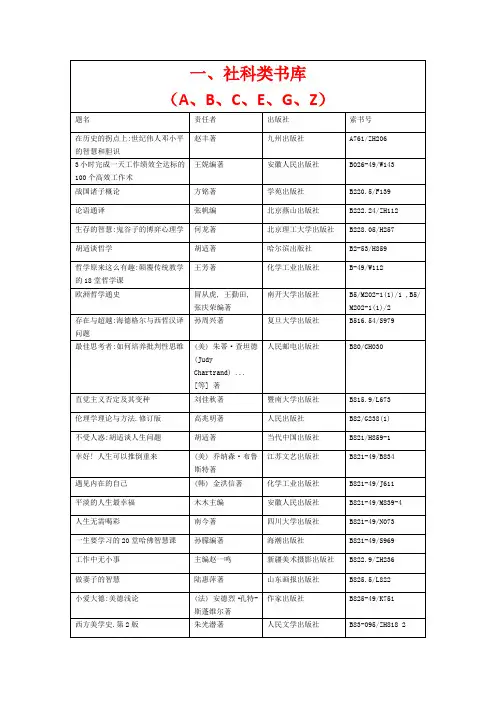
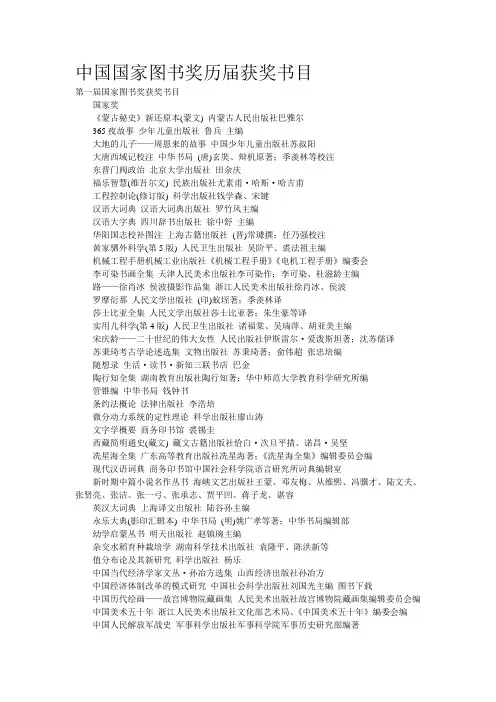
中国国家图书奖历届获奖书目第一届国家图书奖获奖书目国家奖《蒙古秘史》新还原本(蒙文) 内蒙古人民出版社巴雅尔365夜故事少年儿童出版社鲁兵主编大地的儿子——周恩来的故事中国少年儿童出版社苏叔阳大唐西域记校注中华书局(唐)玄奘、辩机原著;季羡林等校注东晋门阀政治北京大学出版社田余庆福乐智慧(维吾尔文) 民族出版社尤素甫·哈斯·哈吉甫工程控制论(修订版) 科学出版社钱学森、宋键汉语大词典汉语大词典出版社罗竹风主编汉语大字典四川辞书出版社徐中舒主编华阳国志校补图注上海古籍出版社(晋)常璩撰;任乃强校注黄家驷外科学(第5版) 人民卫生出版社吴阶平、裘法祖主编机械工程手册机械工业出版社《机械工程手册》《电机工程手册》编委会李可染书画全集天津人民美术出版社李可染作;李可染、杜滋龄主编路——徐肖冰侯波摄影作品集浙江人民美术出版社徐肖冰、侯波罗摩衍那人民文学出版社(印)蚁垤著;季羡林译莎士比亚全集人民文学出版社莎士比亚著;朱生豪等译实用儿科学(第4版) 人民卫生出版社诸福棠、吴瑞萍、胡亚美主编宋庆龄——二十世纪的伟大女性人民出版社伊斯雷尔·爱泼斯坦著;沈苏儒译苏秉琦考古学论述选集文物出版社苏秉琦著;俞伟超张忠培编随想录生活·读书·新知三联书店巴金陶行知全集湖南教育出版社陶行知著;华中师范大学教育科学研究所编管锥编中华书局钱钟书条约法概论法律出版社李浩培微分动力系统的定性理论科学出版社廖山涛文字学概要商务印书馆裘锡圭西藏简明通史(藏文) 藏文古籍出版社恰白·次旦平措、诺昌·吴坚冼星海全集广东高等教育出版社冼星海著;《洗星海全集》编辑委员会编现代汉语词典商务印书馆中国社会科学院语言研究所词典编辑室新时期中篇小说名作丛书海峡文艺出版社王蒙、邓友梅、从维熙、冯骥才、陆文夫、张贤亮、张洁、张一弓、张承志、贾平凹、蒋子龙、谌容英汉大词典上海译文出版社陆谷孙主编永乐大典(影印汇辑本) 中华书局(明)姚广孝等著;中华书局编辑部幼学启蒙丛书明天出版社赵镇琬主编杂交水稻育种栽培学湖南科学技术出版社袁隆平、陈洪新等值分布论及其新研究科学出版社杨乐中国当代经济学家文丛·孙冶方选集山西经济出版社孙冶方中国经济体制改革的模式研究中国社会科学出版社刘国光主编图书下载中国历代绘画——故宫博物院藏画集人民美术出版社故宫博物院藏画集编辑委员会编中国美术五十年浙江人民美术出版社文化部艺术局、《中国美术五十年》编委会编中国人民解放军战史军事科学出版社军事科学院军事历史研究部编著中国共产党历史(1921年-1949年) 人民出版社中共中央党史研究室编中国石窟——敦煌莫高窟文物出版社敦煌研究院编中国土壤(第2版)科学出版社熊毅、李庆逵主编中国岩石圈动力学(挂图、图集、概论) 地质出版社马杏垣主编中国及邻区特提斯海的演化地质出版社黄汲清、陈炳蔚周恩来传人民出版社金冲及主编荣誉奖辞海(1989年版)上海辞书出版社夏征农主编甲骨文合集中华书局郭沫若主编;中国社会科学院历史研究所编鲁迅全集(新注释本) 人民文学出版社鲁迅著;鲁迅著作编辑室编离心叶轮的内流理论基础浙江大学出版社沈天耀编著中国大百科全书中国大百科全书出版社《中国大百科全书》编辑委员会编中国历史地图集中国地图出版社谭其骧主编中国美术全集人民美术出版社中国美术全集编辑出版委员会编乾隆版大藏经文物出版社雍正始刊刻,乾隆时期完成;文物出版社整理、补版第二届国家图书奖获奖书目国家奖朝鲜语词典(共3卷)延边人民出版社金琪钟邓小平思想研究(共3卷) 国防大学出版社钱抵千等高士其全集(共4卷)安徽少年儿童出版社高士其著中国科普研究所编建筑设计资料集(第二版)中国建筑工业出版社建筑设计资料编委会蒙古族民歌集成内蒙古文化出版社中国民间文学集成内蒙古分卷编委会泌尿外科山东科学技术出版社吴阶平主编求索丛书(共10卷)陕西人民教育出版社钟启泉等世界反法西斯文学书系(共52卷)重庆出版社刘白羽等思辨随笔上海文艺出版社王元化天线罩电信设计方法国防工业出版社杜耀惟现代公司与企业改革天津人民出版社吴敬琏刑法学原理(共3卷) 中国人民大学出版社高铭暄叶圣陶教育文集(共5卷)人民教育出版社叶圣陶著刘国正编英藏敦煌文献——汉文佛经以外部分(共14卷)四川人民出版社中国社会科学院历史研究所等元明清名家绘画系列(共5卷)天津人民美术出版社天津人民美术出版社编战争和人(共3部)人民文学出版社王火浙江植物志浙江科学技术出版社浙江植物志编辑委员会中国近代文学发展史山东教育出版社郭延礼中国抗日战争史(共3卷) 军事科学院军事历史研究部中国矿床(上、中、下册)地质出版社宋叔和等中国三峡江苏人民出版社《中国三峡》编委会中国通史(共10卷) 人民出版社范文澜蔡美彪中国文物精华大全(共4卷)上海辞书出版社彭卿云等中国伊斯兰百科全书四川辞书出版社宛耀宾等中国婴幼儿百科(共100册)海燕出版社茅于燕、郑延慧中国玉器全集(共6卷)河北美术出版社杨伯达等中华美德图说(共8卷)二十一世纪出版社钟起煌浦漫汀中药药理研究方法学人民卫生出版社陈奇等宗白华全集(共4卷) 安徽教育出版社宗白华荣誉奖巴金全集(共26集)人民文学出版社王仰晨荣誉奖冰心全集(共8卷)海峡文艺出版社冰心著卓如编荣誉奖闻一多全集(共12卷)湖北人民出版社闻一多著孙党伯等编荣誉奖学术论著自选集(共21卷)首都师范大学出版社钱伟长等荣誉奖殷周金文集成(共18卷)中华书局中国社会科学院考古研究所荣誉奖中国古建筑大系(共10卷)中国建筑工业出版社程里尧等荣誉奖中国军事百科全书(共58卷)军事科学出版社军事科学院军事百科研究部荣誉奖第三届国家图书奖获奖书目国家奖楚学文库湖北教育出版社张正明主编国家奖船山全书岳麓书社本书编委会国家奖丹珠尔(藏文)中国藏学出版社崔成仁钦等国家奖敦煌石窟艺术江苏美术出版社段文杰等国家奖复杂系统中的电磁波复旦大学出版社金亚秋国家奖旷代逸才——杨度湖南文艺出版社唐浩明国家奖李白全集校注汇释集评百花文艺出版社詹锳国家奖岭南文库广东人民出版社于幼军主编国家奖毛泽东传中央文献出版社中央文献研究室编国家奖潘天寿书画集浙江人民美术出版社潘公凯编国家奖普通话基础方言基本词汇集语文出版社陈章太等国家奖齐白石全集湖南美术出版社郭天民等编国家奖塞万提斯全集人民文学出版社董燕生等译国家奖神脑聪仔卡通系列丛书接力出版社聪仔工作室国家奖肾脏病学人民卫生出版社王海燕等国家奖世纪之交:与高科技专家对话辽宁教育出版社朱丽兰主编国家奖西方经济发展思想史(修订本)武汉大学出版社谭崇台国家奖现代科学技术博览丛书上海科技教育出版社朱光亚等国家奖小鳄鱼丛书海燕出版社孙幼军等国家奖医药志(哈萨克文)乌太波依达克国家奖中国道教史四川人民出版社卿希泰国家奖中国地球物理图集地质出版社袁学诚等国家奖中国农业现代化建设理论道路与模式山东科学技术出版社卢良恕等国家奖中国文学批评通史上海古籍出版社王运熙等国家奖中国戏曲剧种大辞典上海辞书出版社中国戏曲剧种大辞典编委会国家奖中国针灸四大通鉴青岛出版社邓良月等主编国家奖中国政治制度通史人民出版社白钢主编国家奖中国著名特级教师教学思想录江苏教育出版社柳斌主编国家奖教育投入与产出研究河北教育出版社王善迈转移核糖核酸——结构、功能与合成浙江科学技术出版社王德宝等国家奖红军长征史辽宁人民出版社中央党史研究室第一研究部荣誉奖曹禺全集花山文艺出版社田本相等主编世纪伟人邓小平中共中央党校出版社徐佑珠韬奋全集中国韬奋基金会韬奋著作编辑部张岱年全集河北人民出版社张岱年中国大百科全书(简明版)中国大百科全书出版社中国大百科全书出版社编辑部中国近代文学大系上海书店徐中玉等主编中国农业百科全书中国农业出版社本书编委会中华大藏经中华书局任继愈主编第四届国家图书奖获奖书目国家奖比较法研究北京大学出版社沈宗灵著国家奖不知道的世界(10卷) 中国少年儿童出版社陈海燕主编国家奖蔡元培年谱长编(4卷) 人民教育出版社高平叔著国家奖藏传历算学大全(5卷) 四川民族出版社本书编写组编写国家奖草房子江苏少年儿童出版社曹文轩著国家奖大科学家讲的小故事(4卷) 湖南少年儿童出版社苏步青等著国家奖电机工程手册(第二版)(8卷) 机械工业出版社本书编委会编国家奖冬小麦种质创新与评价利用山东科学技术出版社李晴祺主编国家奖敦煌学大辞典上海辞书出版社季羡林主编国家奖俄汉详解大词典(4卷) 黑龙江人民出版社黑龙江大学辞书研究所编纂国家奖尔雅诂林(6卷) 湖北教育出版社朱祖延主编国家奖郭店楚墓竹简文物出版社荆门市博物馆编国家奖荷马史诗(《伊利亚特》、《奥德赛》)(2卷) 人民文学出版社罗念生等译国家奖胡绳全书(6卷) 人民出版社胡绳著国家奖黄帝内经研究大成(3卷) 北京出版社王洪图总主编国家奖季羡林文集(24卷) 江西教育出版社季羡林著国家奖教育哲学通论山西教育出版社黄济著国家奖科学的丰碑——20世纪重大科技成就纵览山东科学技术出版社陈建礼主编国家奖名家点评大师佳作——中国画、欧洲油画(2卷) 山东美术出版社王伯敏主编国家奖南明史中国青年出版社顾诚著国家奖农业大词典中国农业出版社本书编委会编国家奖青藏高原研究从书(5卷) 广东科技出版社汤懋苍等主编国家奖世纪木鼓云南人民出版社黄尧著国家奖唐五代文学编年史(4卷)辽海出版社傅璇琮主编国家奖王朝闻集(22卷) 河北教育出版社王朝闻著国家奖现代蒙古语频率词典内蒙古教育出版社达·巴特尔等主编国家奖校雠广义(4卷) 齐鲁书社(副牌) 程千帆等著国家奖亚里士多德全集(10卷) 中国人民大学出版社苗力田主编国家奖扬州画派书画全集(12卷) 天津人民美术出版社薛永年等著国家奖彝文经籍文化辞典京华出版社马学良主编国家奖智能自动化丛书(6卷) 浙江科学技术出版社戴汝为主编国家奖中国军事史图集(2卷) 湖南人民出版社中国军事博物馆编纂国家奖中国民族工商业发展史河北人民出版社王相钦主编国家奖中国农村改革二十年河北科学技术出版社关锐捷主编国家奖中国青铜器全集(16卷) 文物出版社本书编委会编国家奖中国新时期幼儿文学大系(6卷) 未来出版社张美妮等主编国家奖中国制造作家出版社周梅森著国家奖中国主要人工林树种木材性质中国林业出版社鲍甫成等著国家奖中外教育比较史纲(3卷) 山东教育出版社张瑞璠等主编国家奖肿瘤的诱导分化和凋亡疗法上海科学技术出版社王振义等主编国家奖荣誉奖蔡元培全集(18卷) 浙江教育出版社中国蔡元培研究会编荣誉奖化工百科全书(20卷) 化学工业出版社本书编委会编荣誉奖老舍全集(19卷) 人民文学出版社老舍著荣誉奖李俨钱宝琮科学全集(10卷) 辽宁教育出版社李俨钱宝琮著荣誉奖全宋诗(72册) 北京大学出版社北京大学古文献研究所编荣誉奖现代汉语方言大词典江苏教育出版社李荣主编荣誉奖新华字典(1998年修订本)商务印书馆中国社会科学院语言研究所词典编辑室编荣誉奖郑振铎全集(20卷) 花山文艺出版社郑振译等著荣誉奖中国音乐文物大系(8卷) 大象出版社本书总编辑部编荣誉奖中华文化通志(101卷) 本书编委会编荣誉奖朱自清全集(12卷) 江苏教育出版社朱自清等著荣誉奖第五届国家图书奖获奖书目国家奖《20世纪中国美术——中国美术馆藏品选》浙江人民美术出版社刘曦林等主编国家奖《Mathematics Mechanization(数学机械化) 》科学出版社吴文俊著国家奖《八大山人全集》江西美术出版社王朝闻主编国家奖《大雪无痕》吉林人民出版社陆天明著国家奖《当代世界军事与中国国防》军事科学出版社张万年等编撰国家奖《冯至全集》河北教育出版社冯至著刘福春等编国家奖《共和国的脊梁:“两弹一星”功勋谱》黑龙江教育出版社李迅主编国家奖《好阿姨新童话系列丛书》福建少年儿童出版社金波主编国家奖《华夏审美风尚史》河南人民出版社许明主编国家奖《马寅初全集》浙江人民出版社马寅初著田雪原主编国家奖《漫画金头脑丛书》北京少年儿童出版社张开逊主编国家奖《乔木文丛》人民出版社胡乔木著?《胡乔木传》编写组编国家奖《上海通史》(15卷) 熊月之主编国家奖《水下机器人》辽宁科学技术出版社蒋新松等编著国家奖《汤用彤全集》河北人民出版社汤用彤著汤一介主编国家奖《唐宋时期的雕版印刷》文物出版社宿白著国家奖《天界》岭南美术出版社林晶华编著国家奖《王力古汉语字典》中华书局王力主编国家奖《显密文库》(1-5卷) 四川民族出版社隆钦阙英·朵登多吉著国家奖《新中国经济史》中共中央党校出版社苏星著国家奖《应用心理学书系》人民教育出版社林崇德主编国家奖《增订文心雕龙校注》中华书局杨明照校注国家奖《中国地质学》(扩编版) 地质出版社李四光原著《中国地质学》扩编委员会编著国家奖《中国教育制度通史》山东教育出版社李国钧等总主编国家奖《中国历史大辞典》上海辞书出版社郑天挺等主编国家奖《中国森林》中国林业出版社吴中伦等著国家奖《中国水力发电工程》中国电力出版社周大兵等编著国家奖《中华内科学》人民卫生出版社陈敏章主编国家奖《朱德熙文集》商务印书馆朱德熙著国家奖《最新玉篇》辽宁民族出版社文淑东等主编国家奖荣誉奖《不列颠百科全书》(国际中文版)中国大百科全书出版社徐慰曾主编荣誉奖《大中华文库》(第一辑)湖南人民出版社《大中华文库》编委会编荣誉奖《顾毓琇全集》辽宁教育出版社顾毓琇著杨义等主编荣誉奖《胡风全集》湖北人民出版社胡风著梅志等整理荣誉奖《科学与艺术》上海科学技术出版社李政道等主编荣誉奖《李大钊全集》河北教育出版社《李大钊全集》编委会编荣誉奖《纳西东巴古籍译注全集》(100卷)云南人民出版社东巴文化研究所编荣誉奖《钱学森手稿》山西教育出版社钱学森著郑哲敏主编荣誉奖《田汉全集》花山文艺出版社《田汉全集》编委会编荣誉奖《中国古代书画图目》文物出版社中国古代书画鉴定组编荣誉奖《中华本草》上海科学技术出版社《中华本草》编委会编荣誉奖第六届国家图书奖获奖书目荣誉奖1 郭沫若全集·考古编(10卷)科学出版社2 吕叔湘全集(19卷)辽宁教育出版社3 梁思成全集中国建筑工业出版社4贾祖璋全集(5卷)福建科学技术出版社5 波斯经典文库(7种/18卷)湖南文艺出版社6 茅盾全集人民文学出版社7 中国文物定级图典(一、二、三级品)上海辞书出版社网上购书8 中国少数民族古籍集成(100册)四川民族出版社9 续修四库全书(1800册)上海古籍出版社10 日本宫内厅书陵部藏宋元版汉籍影印丛书(第一辑)线装书局11 中国美术分类全集·中国绘画全集文物出版社浙江人民美术出版社12 中国美术分类全集·中国民间美术全集(6卷)人民美术、浙江人美、吉林美术、江苏美术、广西美术正式奖序号书名出版者1 中国佛教哲学要义中国人民大学出版社2 信息社会与网络经济长春出版社3 二十世纪中国史学名著(33卷)河北教育出版社4 中国现代化历程(一、二、三卷)江苏人民出版社5 比较刑法原理----外国刑法学总论武汉大学出版社6 二十世纪现代汉语语法"八大家" 东北师范大学出版社7 文明消失的现代启悟内蒙古大学出版社8 中国鲁迅学通史--20世纪一种精神文化现象的宏观描述、微观透视与理性反思广东教育出版社9 无字北京十月文艺出版社10 吴梅全集河北教育出版社11 永远的三峡人民美术出版社12 中国书法史江苏教育出版社13 中国古代门窗中国建筑工业出版社14中国物理学史大系(9卷)湖南教育出版社15时序逻辑程序设计与软件工程(上、下)科学出版社16 中国丝绸科技艺术七千年----历代织绣珍品研究中国纺织出版社17 杂交水稻学中国农业出版社18 实用外科学(第二版)人民卫生出版社19 解读生命丛书北京教育出版社北京少年儿童出版社20院士数学讲座专辑(3册)中国少年儿童出版社21 教育科学分支学科丛书(15卷)人民教育出版社22 外国教育思想通史(10卷)湖南教育出版社23 现代汉语方言大词典江苏教育出版社24 中国儿童百科全书中国大百科全书出版社25 全清词·顺康卷中华书局26 李商隐文编年校注中华书局27 德格印经院藏传木刻版画集四川民族出版社28 突厥语大词典民族出版社29 无人区科学探险系列湖南少年儿童出版社30 中华文明大视野21世纪出版社第七届“中国图书奖”获奖书目书名作者出版社邓小平的生平、思想研究丛书金羽、王充闾辽宁人民邓小平科学技术思想研究潘琦主编广西科技中国共产党廉政建设史吴传煌、刘录开主编甘肃人民海外经济管理运作丛书吕东、徐惟诚主编人民中国解放区文学书系林默涵总主编重庆新编文史笔记丛书萧乾主编上海书店中华文库许力以、林言椒主编生活·读书·新知三联书店中国古文献研究丛书金开诚主编江苏古籍中国敦煌学史林家平、宁强等著北京语言学院90年代中国出口战略研究徐祖权主编中国对外经贸综合国力论黄硕风著中国社科中国少数民族哲学史萧万源、伍雄武等主编安徽人民社会主义市场经济探索孙家贤主编浙江人民中华20世纪丛书许力以主编青岛中华魂丛书姜春云主编山东人民存量资源的再配置宋宁著云南人民县级领导工作的理论与实践黄美来、张江垠主编广西人民资产重组:中国企业兼并研究常修泽主编陕西人民扫描隧道显微术及其应用白春礼编著上海科技毛泽东研究事典邢崇智、蒋顺学等主编河北人民建立社会主义市场经济新体制马洪著河南人民非线性传递函数理论与应用焦李成著西安电子科大神奇的南极丛书郭琨、金涛主编海燕中国工农红军第一方面军史本书编审委员会编解放军从延安走向世界牛军著福建人民建立社会主义市场经济新体制王珏、刘国光等著黑龙江人民青年看社会丛书李树人等主编天津人民中青年法学文库丛书王利明、陈兴良等著中国政法大学走出封闭——中国内陆省份改革开放大思路王茂林、杨汝岱等著湖南农业经济系统分析陈锡康、王正等编著华中理工大学中国农垦经济学刘以雷著新疆人民反通货膨胀论刘涤源主编广东人民投资知识百科全书徐文通、林森木等主编中国金融股票债券全书金建栋、吴晓求等主编北京理工大学中日消费者保护制度比较研究许思奇著辽宁大学中国西北地区开发与向西开放余振贵、张永庆著宁夏人民相似论张光鉴等著江苏科技自由刑比较研究李贵方著吉林人民周易美学刘纲纪著湖南教育汉语史断代研究丛书程湘清主编山东教育东北文化丛书刘烈恒主编春风文艺沈从文别集沈从文著岳麓书社古代小说评介丛书侯忠义、安平秋主编辽宁教育中国历代史话卜孝萱、程应等主编北京苗族史伍新福、龙伯亚著四川民族理论地理学朱文元编著商务印书馆近代中国社会的新陈代谢陈旭麓著上海人民朱子大传束景南著福建教育最新发掘唐宋歌曲李健正编四川人民复合材料中的边界元法田宗若著西北工大华北南部的逆冲推覆伸展滑覆与重力滑动构造王桂梁、曹代勇等著中国矿大并行算法李晓梅、蒋增荣等著湖南科技高效液相色谱法及其专家系统卢佩章、张玉奎等著辽宁科技弹刃发射过程理论芮筱亭、杨启仁著东南大学随机参数结构的振动理论陈塑寰著吉林科技中国人口与环境曲格平、李金昌著环境科学中国含油气盆地沉积学吴崇筠、薛叔浩等著石油工业中子活化分析在环境学、生物学和地学中的应用中国科学院高能物理研究所中子活化分析室著原子能中国自然灾害地图集张兰生、李裕民主编科学价值工程方法研究谭浩邦编著广东科技。
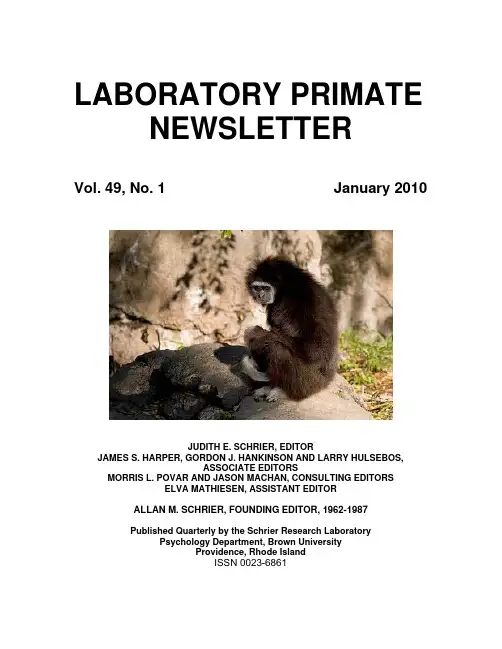
LABORATORY PRIMATE NEWSLETTERVol. 49, No. 1 January 2010JUDITH E. SCHRIER, EDITORJAMES S. HARPER, GORDON J. HANKINSON AND LARRY HULSEBOS,ASSOCIATE EDITORSMORRIS L. POVAR AND JASON MACHAN, CONSULTING EDITORSELVA MATHIESEN, ASSISTANT EDITORALLAN M. SCHRIER, FOUNDING EDITOR, 1962-1987Published Quarterly by the Schrier Research LaboratoryPsychology Department, Brown UniversityProvidence, Rhode IslandISSN 0023-6861POLICY STATEMENTThe Laboratory Primate Newsletter provides a central source of information about nonhuman primates and related matters to scientists who use these animals in their research and those whose work supports such research. The Newsletter (1) provides information on care and breeding of nonhuman primates for laboratory research, (2) disseminates general information and news about the world of primate research (such as announcements of meetings, research projects, sources of information, nomenclature changes), (3) helps meet the special research needs of individual investigators by publishing requests for research material or for information related to specific research problems, and (4) serves the cause of conservation of nonhuman primates by publishing information on that topic. As a rule, research articles or summaries accepted for the Newsletter have some practical implications or provide general information likely to be of interest to investigators in a variety of areas of primate research. However, special consideration will be given to articles containing data on primates not conveniently publishable elsewhere. General descriptions of current research projects on primates will also be welcome.Newsletter appears quarterly and is intended primarily for persons doing research with nonhuman primates. TheBack issues may be purchased for $10.00 each. We are no longer printing paper issues, except those we will send to subscribers who have paid in advance. We will not accept future subscriptions, unless subscribers are willing to pay $100/year. (Please make checks payable to the Brown University Psychology Department.) Readers with access to electronic mail may receive a notice when a new issue is put on the Website by sending the message subscribe LPN-WARN your-own-name to listserv@. (Send the message subscribe LPN-PDF to receive PDF files by e-mail; or the message subscribe LPN-L to receive the nongraphic contents of each issue.) Current and back issues of the Newsletter are available on the World Wide Web at </primate>. Persons who have absolutely no access to the Web, or to the electronic mailing, may ask to have paper copies sent to them.The publication lag is typically no longer than the three months between issues and can be as short as a few weeks. The deadline for inclusion of a note or article in any given issue of the Newsletter has in practice been somewhat flexible, but is technically the tenth of December, March, June, or September, depending on which issue is scheduled to appear next. Reprints will not be supplied under any circumstances, but authors may reproduce their own articles in any quantity.PREPARATION OF ARTICLES FOR THE NEWSLETTER. – Articles, notes, and announcements may be submitted by mail, e-mail, or computer disk, but a printed copy of manuscripts of any length or complexity should also be sent by regular mail. Articles in the References section should be referred to in the text by author(s) and date of publication, e.g., Smith (1960) or (Smith & Jones, 1962). Names of journals should be spelled out completely in the References section. Latin names of primates should be indicated at least once in each note and article. In general, to avoid inconsistencies within the Newsletter, the Latin names used will be those in Mammal Species of The World: A Taxonomic and Geographic Reference, 2nd Ed. D. E. Wilson & D. M. Reeder (Eds.). Washington, DC: Smithsonian Institution Press, 1993. For an introduction to and review of primate nomenclature see The Pictorial Guide to the Living Primates, by N. Rowe, Pogonias Press, 1996.All correspondence concerning the Newsletter should be addressed to:Judith E. Schrier, Psychology Department, Box 1853, Brown UniversityProvidence, Rhode Island 02912 [401-863-2511; FAX: 401-863-1300]e-mail address: primate@Current and back issues of the Newsletter are available on the World Wide Web at/primateACKNOWLEDGMENTSThe Newsletter is supported by Brown University.Cover photograph of a white-handed gibbon (Hylobates lar),taken at the San Diego Zoo by Mark Abbott in 2007Copyright © 2010 by Brown UniversityInformation Requested or AvailableSpecific Gravity of Primates’ UrineBrooke Aldrich, of the Monkey Sanctuary Trust, Looe, Cornwall, PL13 1NZ, U.K. [Phone and fax: 01503 262 532; e-mail: email@] has been trying to monitor the health of an elderly female patas monkey (Erithrocebus patas). Part of the monitoring is regular ‘multistix’ tests of her urine. Multistix measure a variety of things (glucose, protein, and so on). “Most of them we have a grip on but normal specific gravity seems to vary between humans, cats, and dogs and I can only assume different primate species have different ‘normal’ measures. If anyone can furnish values, or references to values, for patas monkeys (and, for that matter, other pri-mate species, such as Barbary macaques, various capu-chins, woolly monkeys), we will be very grateful.”The Enrichment Record“The first issue of The Enrichment Record is now available online. This quarterly E-Zine has been created by and for the laboratory animal research community as an online forum for:∙discussing environmental enrichment in the optimal care of laboratory animals;∙documenting best practices and approaches for ad-dressing challenges of implementation and assess-ment at every level;∙sharing data on the impact of environmental enrich-ment on science; and ∙building the case for integrating enrichment into re-search design.“This community-based publication is not peer-reviewed. However, members of our Editorial Board are actively involved in all aspects of the publication. If you want to write an article, submit a topic for discussion, or have any suggestions for ways to expand and engage our community in a lively dialogue on this subject, please contact Jayne Mackta [732.869.9499; e-mail: mackta@].“Subscriptions are free; the potential benefit to lab animal welfare of sharing is priceless. We encourage youto subscribe and to spread the word about this new re-source; see </enrichrecord.html>.”More Interesting Websites∙ American Association for Laboratory Animal Science (AALAS)’s online Buyers Guide: <>∙Animal Technology and Welfare: <. uk>∙ Legal Books from LexisNexis: <www.lexisnexis. com/store/catalog/category_lawfirms.jsp?segmentid=seg_law>∙ National Association for Biomedical Research’s Animal Law Section: <>* * *Primatology, Wildlife Ecology, and Conservation Field SchoolJack Harris, Professor of Anthropology, Rutgers Uni-versity, and Co-Director of Field Schools, Kenya, recently wrote to the Primate-Science mailing list: “The fourth annual Primatology, Wildlife Ecology, and Conservation Field School will be held from August 3rd – 28th, 2010, in Kenya. This field school is a joint effort of Rutgers University, the National Museums of Kenya, and the Kenya Wildlife Services.“The field school provides a distinctive opportunity for students to gain hands-on experience in field work methodologies and research on some of Kenya’s exquisite wildlife including a variety of Old World primates. One site we will visit is the Tana River Primate National Re-serve where students will conduct independent research projects and have the opportunity to observe not only the two endemic and endangered species, the Tana River mangabey and Tana River red colobus, but also yellow baboons and Sykes monkeys.“We will also spend time on the Laikipia Plateau of central Kenya. At the different sites where we camp, stu-dents will receive lectures, complete readings, and have discussions with the Field School directors as well as a wide range of consultants to the Field School including Dr. Martin Mulama of Sweetwaters Chimpanzee Sanctu-ary, Dr. Paul Muoria of the African Wildlife Foundation, and Dr. Daniel Rubenstein of Mpala Research Centre, to name a few. In addition, we will stay on Mugie Ranch where we will visit their black rhino sanctuary and data collection lab. We will observe radio-collared lions and learn about the Laikipia Predator Project from Project Biologist Alayne Cotterill. Students will also do field work, making the Field School worth six academic cred-its.“To obtain more information about this program, see <>, contact me directly at <jwharris@>, or visit the Rutgers Study Abroad Website at <>.”News BriefsFBR’s New CampaignThe Foundation for Biomedical Research (FBR) commissions public opinion polls and has found a precipi-tous drop in public support of animal research, from 64% in 2004 to 54% in 2008. In response, FBR recently launched ResearchSaves, a campaign to explain why ani-mal research is an essential step in finding new treatments and cures for disease. “ResearchSaves corrects miscon-ceptions about biomedical research and stresses that ani-mal research is important, humane, and necessary to save lives,” FBR president Frankie Trull said. The campaign includes a robust media strategy to reach as many Ameri-cans as possible, including national TV and radio spots, billboards in select markets, social media outreach through Twitter and Facebook, and ResearchSaves, a quarterly magazine that highlights the latest medical breakthroughs with foundations in animal research. – FBR’s The Research Advocate, September 9Successful Congo Basin Forest PartnershipThe Congo Basin Forest Partnership consists of an in-ternational association of more than forty governments, international organizations, and private sector and civil society representatives and is designed to enhance the sustainable management of the Congo Basin ecosystem. The Partnership promotes economic development, pov-erty alleviation, and effective governance through the conservation and sustainable management of natural re-sources, including forests and wildlife. It serves as a global model of public/private cross-boundary coopera-tion and has resulted in improved sustainable forest man-agement, new multi-national, anti-poaching initiatives, and a declining rate of biodiversity loss for a rainforest area larger than Texas.The United States government has invested more than $100 million in funds and technical expertise into the Partnership over the last ten years. By the end of 2009, through the Central Africa Regional Program for the En-vironment (CARPE), U.S. programs have improved land management of 56 million hectares; trained nearly 25,000 people in conservation; put in place ten forestry, biodiver-sity, and conservation laws; allocated $2.5 million in small grants to local NGOs; provided for logging conces-sion monitoring in Cameroon, Central African Republic, the Republic of Congo, Gabon, and the Democratic Re-public of Congo (DRC); and completed a logging title conversion process in the Democratic Republic of Congo, with additional support from the World Bank and the European Union.Established at the 2002 World Summit on Sustainable Development, the Partnership operates within the frame-work of the Council of Ministers in charge of the Forests of Central Africa (COMIFAC: <>) and in accordance with its strategic plan, the Plan de Convergence. The Partnership focuses on 12 ecologically sensitive and biologically diverse areas and wildlife corri-dors called forest landscapes, which are viewed as the most vulnerable to deforestation and other threats to bio-diversity. Together, these landscapes comprise more than 80 million hectares of critically important tropical forest in Central Africa.Other U.S. agencies that have invested in the Congo Basin Forest Partnership include the U.S. Agency for In-ternational Development, the U.S. Forest Service, and the U.S. Fish and Wildlife Service. – U.S. Dept of State Press Release: September 29, 2009Grand Opening of Baboon Cliffs ExhibitA ribbon cutting ceremony took place October 1 at the Oakland (California) Zoo to celebrate the grand opening of the new Baboon Cliffs Exhibit. The Baboon Cliffs Exhibit is approximately 8,100 square feet and includes a cascading waterfall, climbing structures, a spacious area for the baboons to roam, a night house facility, and offices for Zoo staff. The exhibit also has a large viewing deck for the public. – Press release, October 1, 2009 Extended Habitat for the Greater Bamboo Lemur One of the world’s most endangered primates, the greater bamboo lemur, a species endemic to Madagascar, has been found in an area where it was feared extinct, environmental organizations said on October 5. The spe-cies, Prolemur simus, has been found at 11 sites in a swath of forest in the east of the island. This finding opens “a new chapter for the species and for the places we can protect it by preserving the forest as the main problem is loss of habitat,” Mahaoly Ravaloharimanitra, a research assistant at the Aspinall Foundation, told Agence France-Press (AFP).Illegal logging and slash-and-burn agriculture are among the practices that threaten the survival of this spe-cies. Primate specialists say that while this type of lemur was once found throughout this Indian Ocean island, now no more than 300 individuals are still in existence. As its common name suggests, Prolemur simus feeds mainly on bamboo, which limits its habitat options. “They are very secretive, which makes it difficult to approach them and protect them. Most of the time we don’t see the animal, just traces of food or droppings,” Tovanahary Rasolofo-harivelo from Conservation International told AFP.The greater bamboo lemur was thought to be extinct until it was rediscovered in the 1980s, the two associa-tions said in a statement. – Copyright © 2009 AFPMore U.S. Law Schools Have Animal Law Courses Over half of U.S. law schools now have animal law courses, including many in universities with medical and research programs that utilize animals protected by fed-eral welfare laws. Courses that promote standards for humane animal care and welfare are unlikely to provoke conflict, but programs championing animal rights or “lib-eration” set up adversarial potential on campuses and pose a serious risk to the future of animal research. The use of the law instead of violence and threats, however, should be acknowledged as a forward step.According to the course catalogues of 203 law schools listed on the Website for the Law School Admissions Council <>, 111 (55%) teach an animal law course. Of 121 student groups throughout U.S. law schools with a focus on animal law and animal rights, 85 are at schools with an animal law class while 37 are at schools without such a class. Accordingly, animal law, through either coursework or student groups, is being addressed at 148 (73%) of U.S. law schools. – P. Michael Conn, in The Scientist, 2009, 23[12], 23* * *Position Available: The Animal Welfare InstituteThe Animal Welfare Institute in Washington DC is accepting applications for its full-time position of Labora-tory Animal Advisor.Candidates are expected to:∙have a genuine reverence for living creatures;∙not be afraid to actively express compassion for ani-mals kept in research laboratories and educational in-stitutions;∙not be categorically against research with animals;∙not be categorically for research with animals;∙have several years of experience with traditional and refined housing and handling practices for at least one nonhuman primate species and at least one non-primate species commonly found in research labs;∙be familiar with the professional and scientific litera-ture pertaining to the housing and handling of ani-mals assigned to research and teaching projects;∙have published several professional or scientific arti-cles (a copy of one article should be attached to the application);∙publish articles on species-adequate housing and stress-mitigating handling of animal species com-monly found in laboratories;∙visit animal research facilities and offer advice on species-adequate housing and stress-mitigating han-dling of animal species commonly found in laborato-ries;∙represent the Animal Welfare Institute at professional and scientific meetings;∙manage and update at a three-month interval two annotated databases on ∙environmental enrichmentand ∙refinement for animals in research institutions;and∙write comments on federal draft regulations and pro-fessional draft guidelines on the housing and han-dling of animals kept in research laboratories.No specific academic or professional diplomas are re-quired to apply for this position, which is presently held by Viktor Reinhardt, who will be retiring. Candidates arefree to specify their salary expectations in their applica-tions. Applications – original and two copies – should bemailed to Cathy Liss, 900 Pennsylvania Ave. SE, Wash-ington, DC 20003, by May 1, 2010. The position will beavailable on September 1, 2010.* * *Call for Nominations: ASLAP Research AwardNominations for the 2010 American Society of Labo-ratory Animal Practitioner’s (ASLAP) Research Award may be submitted, by January 15, 2010, to Dr. Fred Rock (ASLAP Secretary-Treasurer) through the ASLAP Office (Darlene Brown, ASLAP Coordinator, P.O. Box 125, Adamstown, MD 21710 [e-mail: aslap@]). This award was created to honor members in good stand-ing of ASLAP and the American Veterinary Medical As-sociation (AVMA) for scientific contributions to the fields of laboratory animal medicine and/or comparative medicine. The award is intended to honor individuals who have made significant and repeated scientific contri-butions to the field. The scientific contributions may be of significance to refinement or development of technical procedures within laboratory animal medicine which have resulted in contributions to animal welfare, animal hus-bandry, animal health, or development of animal models. Studies which have used laboratory animals and have resulted in significant contributions to human health, ei-ther through basic or applied research, are also applicable. While the award is not intended to be for recognition of administrative accomplishments alone, contributions to the service functions of ASLAP and other professional organizations will also be evaluated.A nomination letter, four to six supporting letters di-rectly relating to the award criteria, and a curriculum vitae should be submitted. Awards will be presented at the AVMA meeting in July of the same year. The awardee will receive a plaque and an honorarium.Resources Wanted and AvailableHousing and Handling Photos WantedViktor Reinhardt is seeking photo material for his sec-ond volume of LAREF discussions (see <labanimals. /pubs/LAREF/LAREF-bk.html> for first volume). If you can and want to share photos related to refinement of housing and handling condi-tions of nonhuman primates, or any other species kept in research institutions, please send them as .JPG files to <viktor@> or as prints to Viktor Reinhardt, 6014 Palmer Dr., Weed, CA 96094 U.S.A. Please include a brief explanation of each picture.NIH Curriculum Supplement: “Exploring Bioethics”“Exploring Bioethics” is a model for ethical inquiry to help students in grades 6 to 12 develop thoughtful positions on complex bioethical issues. The supplement’s six modules each contain three 45-minute class periods of lessons on a specific issue. The topics presented are genetic testing, the use of human subjects in research, steroid use by athletes, organ allocation for transplants, and the modification of animals for hu-man benefit. The lessons promote problem-solving and communication skills, critical thinking, and team-work. The curriculum supplement presents six three-day lessons in a convenient, all-in-one resource that is well organized for integration into a broader curriculum. “Exploring Bioethics” is available at </customers.nsf/ HSBioethics.htm>. – National Institutes of Health, September 15IJCP Freely Available OnlineThe International Journal of Comparative Psychologyis now freely accessible online. For more information, see: <>.Primate Sanctuary Computer Program Update Nedim C. Buyukmihci has announced that an updated version (November 24, 2009) of his Primate Sanctuary Database program is on the Website </pigbyte_psd.html> for down-loading and installing. It has several enhancements (see the Website for list). If you already have the program, you only need to download the update installation file. He recommends you install this update so that you can take advantage of the new features.As stated before, if you are using the program and provide him with an e-mail address, he will place you on the list to notify when an update becomes available. E-mail Ned at <ncbuyukmihci@>. Your address will be kept private. [Editors’ Note: We will not be repeating this announce-ment, so get onto his mailing list!]Australasian Conference AbstractsAbstracts of the 2002, 2007, and 2008 conferences of the Australasian Primate Society are now available at </apsconf.htm>.Updated Guidance in Protocol ReviewThe Guidance section of the Office of Laboratory Animal Welfare (OLAW) home page, <grants.nih. gov/grants/olaw/references/commentary.htm>, has updated its Commentary on Lab Animal Protocol Re-view Columns. “A Word from OLAW and USDA” re-sponds to the topic Required Modifications and Desig-nated Member Reviews in the July, 2009, issue. The No-vember, 2009, issue addresses Categorizing Insufficient Pain Alleviation. To further explore these and other top-ics, browse the OLAW Topic Index. – from the National Institutes of Health, November 28Evolution Versus CreationThis is a Yahoo group, at </ group/evolutionversuscreation>, featuring dis-cussions of past and current events in science, technology, and society.Interspecies Dosage CalculatorThe Federal Drug Administration has brought back the Interspecies Dosage Calculator, which will allow you to convert dosages from mg/kg to mg/sq-m (body surface area) and allow you to determine equivalent doses across species. </Drugs/Development ApprovalProcess/DevelopmentResources/CancerDrugs/UCM189252>. – posted to COMPMED by Bob HarrisFirst Voluntary Gorilla Blood Pressure Reading Zoo Atlanta recently became the first zoological insti-tution in the world to obtain voluntary blood pressure readings from a gorilla. This groundbreaking stride was made possible by the Gorilla Tough Cuff, a blood pres-sure reading system devised through partnership with the Wallace H. Coulter Department of Biomedical Engineer-ing at Georgia Institute of Technology and Emory Uni-versity. Created as a senior design project by biomedical engineering undergraduates David Sotto, Nisha Bhatia, Stephanie Drewicz, and Scott Seaman, the prototype has now been successfully tested on one of Zoo Atlanta’s 22 western lowland gorillas. The students also had guidance from Professors Hanjoong Jo, and Franklin Bost.The Gorilla Tough Cuff operates in the same manner as the mechanism familiar to humans, with the patient slipping an arm into a cuff. As the cuff inflates, the blood pressure reading is measured and displayed on a monitor. The student design team’s biggest set of challenges, how-ever, was constructing a durable, comfortable cuff large enough to fit an adult male gorilla weighing upwards of 300 pounds. The prototype system was comprised of a blood pressure cuff bolted to a casing made of acryloni-trile butadiene styrene plastic. The casing was zip-tied to a rectangular mesh trap and the trap was temporarily at-tached to the gorilla cage. The pressure cuff tubing was connected to an off-the-shelf veterinary blood pressure monitor located outside of the gorilla cage.“We also built a safety mechanism into the device so that the gorillas would not be injured if they became alarmed or frightened and tried to remove their arm from the cuff,” said Sotto, who is currently a graduate student at Georgia Tech.Once the prototype was complete, the Tough Cuff had its first tester: Ozzie, a 48-year-old male western lowland gorilla. Gorillas aren’t typically keen on the idea of in-serting their arms into inflatable cuffs: Ozzie’s accom-plishment is the result of months of patience and diligent voluntary positive reinforcement training on the part of Zoo Atlanta’s Primate Team.One of four geriatric gorillas living at the Zoo, Ozzie is at an age where he may be subject to health concerns similar to those experienced by mature humans. Cardiac disease is the leading cause of mortality in adult male gorillas living in captive settings, and the new system will enable veterinarians to more effectively monitor precur-sory signs such as high blood pressure.The Gorilla Tough Cuff has already been demon-strated for veterinarians and animal care professionals from numerous other accredited zoos. The device could ultimately prove invaluable to the more than 100 institu-tions around the world currently housing the species. – November 10, Georgia Tech press release* * * Announcements from PublicationsBiology Direct Publishes Thematic SeriesIn this Darwin 150th Birthday Year Biology Direct has published the first articles in a thematic series covering today’s understanding of evolution at all levels. See </series/ Darwin_Anniversary>. Further articles will be addedto the series in due course, and proposals are welcome for consideration.Primate Specialist Group’s Publications OnlineAll past editions of the International Union for Conserva-tion of Nature (IUCN) Species Survival Commission (SSC) Primate Specialist Group (PSG)’s newsletters and journals are now available online through the PSG Web-site. These are the Web addresses for each of these publi-cations. All of the following are now available with open access at </journals.htm>.∙Primate Conservation from No 1, 1981: </pc.htm>∙Asian Primates Newsletter from 1[1], 1991: </as.htm>∙Asian Primates Journal from 1[1], 2008: </apj.htm>∙Neotropical Primates from 1[1], 1993: </np.htm>∙African Primates from 1[1], 1995: </ap.htm>∙Lemur News from No. 1, 1996: </ln.htm> African Primates Invites SubmissionsCarolyn L. Ehardt, Senior Editor for the IUCN SSC Primate Specialist Group’s journal African Primates, en-thusiastically invites submissions to that journal from all who conduct research on or have information about Af-rica’s primate species. This journal will now be published as an Open Resource journal, fully indexed, and available worldwide, including to the 1200+ readership that has received printed copies in the past. The journal fell into a prolonged hiatus during the transition between editors, but Ehardt is now expecting the inaugural edition of the revi-talized journal to launch very soon. If any of you or your students/colleagues wish to submit materials for consid-eration for publication in the journal, please do so. The document Notes and Instructions for Contributors to African Primates, which has all relevant information, is available at</PDF/ APguideline.pdf>.African Primates encourages submission of relevant information in the form of research findings, field survey results, advances in field and laboratory techniques, field action alerts, and book reviews, as well as notification of events, funding possibilities, grassroots efforts such as letter-writing campaigns and other activities that might benefit from the support of the readership, and recent pub-lications in other formats (including reports and theses). All submissions should be sent to the Senior Editor [e-mail: Carolyn.Ehardt@]. Research articles are peer-reviewed before acceptance for publication.。
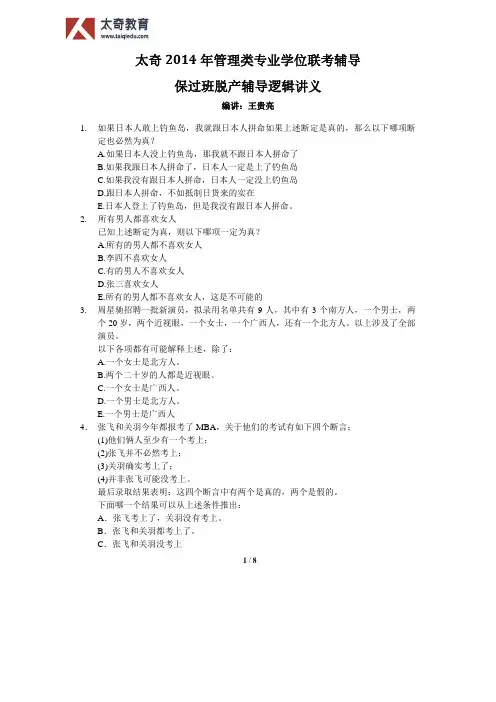
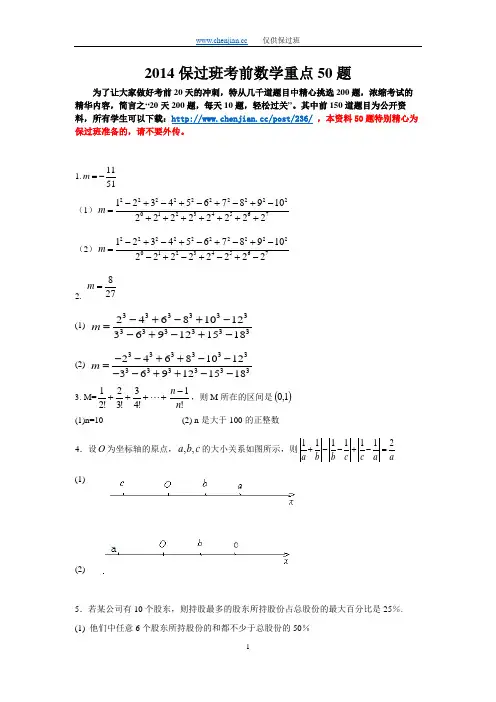
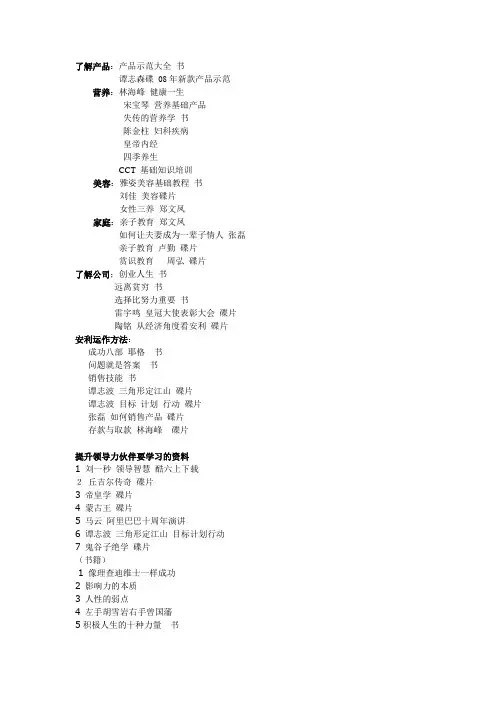
了解产品:产品示范大全书谭志森碟08年新款产品示范营养:林海峰健康一生宋宝琴营养基础产品失传的营养学书陈金柱妇科疾病皇帝内经四季养生CCT 基础知识培训美容:雅姿美容基础教程书刘佳美容碟片女性三养郑文凤家庭:亲子教育郑文凤如何让夫妻成为一辈子情人张磊亲子教育卢勤碟片赏识教育周弘碟片了解公司;创业人生书远离贫穷书选择比努力重要书雷宇鸣皇冠大使表彰大会碟片陶铭从经济角度看安利碟片安利运作方法:成功八部耶格书问题就是答案书销售技能书谭志波三角形定江山碟片谭志波目标计划行动碟片张磊如何销售产品碟片存款与取款林海峰碟片提升领导力伙伴要学习的资料1 刘一秒领导智慧酷六上下载2丘吉尔传奇碟片3 帝皇学碟片4 蒙古王碟片5 马云阿里巴巴十周年演讲6 谭志波三角形定江山目标计划行动7 鬼谷子绝学碟片(书籍)1 像理查迪维士一样成功2 影响力的本质3 人性的弱点4 左手胡雪岩右手曾国藩5积极人生的十种力量书三个月全职工作计划第一个月熟练十款产品示范体验十款以上安利产品、看完产品碟片谭志森和郑浩天的熟练安利opp 至少每天保证一场沟通12场一个月基本电话销售解答疑问每周三天建立五个意向客户每天发20个以上名片并且一个月出30个以上顾客。
目标业绩3000—6900 人数开发至少一个伙伴。
第二个月熟练学会培训伙伴基础能力继续培养三十个以上顾客每天发20张明片学会主持分享,学会讲课提升沟通技巧定下专业方向,学会营养或者美容。
动手熟练团队两个横排业绩完成6900—13800第三个月更加勤奋加大工作量提升自己领导力。
业绩完成1万—13800团队四个横排团队完成3万业绩。
三个月兼职工作计划第一个月熟练十款产品示范体验十款以上安利产品、看完产品碟片谭志森和郑浩天的熟练安利opp 一月八场基本电话销售解答疑问每周三天建立五个意向客户每天发20个以上名片并且一个月出10个以上顾客。
目标业绩3000 人数开发至少一个伙伴。
第二个月熟练学会培训伙伴基础能力继续培养20个以上顾客每天发20张明片学会主持分享,学会讲课提升沟通技巧定下专业方向,学会营养或者美容。
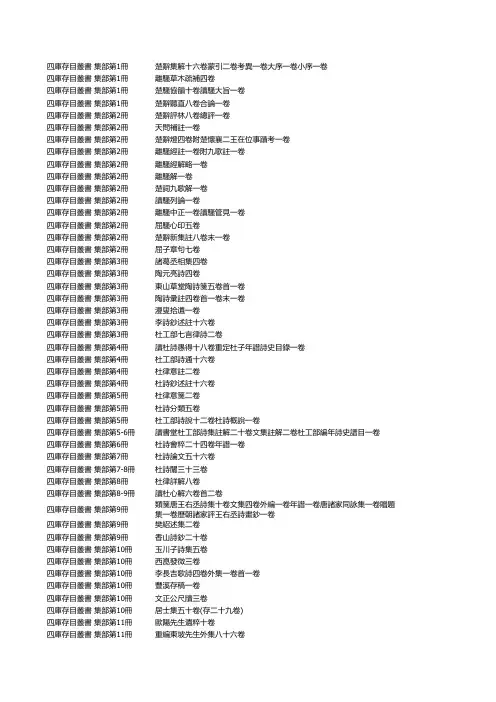
四庫存目叢書集部第1冊楚辭集解十六卷蒙引二卷考異一卷大序一卷小序一卷四庫存目叢書集部第1冊離騷草木疏補四卷四庫存目叢書集部第1冊楚騷協韻十卷讀騷大旨一卷四庫存目叢書集部第1冊楚辭聽直八卷合論一卷四庫存目叢書集部第2冊楚辭評林八卷總評一卷四庫存目叢書集部第2冊天問補註一卷四庫存目叢書集部第2冊楚辭燈四卷附楚懷襄二王在位事蹟考一卷四庫存目叢書集部第2冊離騷經註一卷附九歌註一卷四庫存目叢書集部第2冊離騷經解略一卷四庫存目叢書集部第2冊離騷解一卷四庫存目叢書集部第2冊楚詞九歌解一卷四庫存目叢書集部第2冊讀騷列論一卷四庫存目叢書集部第2冊離騷中正一卷讀騷管見一卷四庫存目叢書集部第2冊屈騷心印五卷四庫存目叢書集部第2冊楚辭新集註八卷末一卷四庫存目叢書集部第2冊屈子章句七卷四庫存目叢書集部第3冊諸葛丞相集四卷四庫存目叢書集部第3冊陶元亮詩四卷四庫存目叢書集部第3冊東山草堂陶詩箋五卷首一卷四庫存目叢書集部第3冊陶詩彙註四卷首一卷末一卷四庫存目叢書集部第3冊漫叟拾遺一卷四庫存目叢書集部第3冊李詩鈔述註十六卷四庫存目叢書集部第3冊杜工部七言律詩二卷四庫存目叢書集部第4冊讀杜詩愚得十八卷重定杜子年譜詩史目錄一卷四庫存目叢書集部第4冊杜工部詩通十六卷四庫存目叢書集部第4冊杜律意註二卷四庫存目叢書集部第4冊杜詩鈔述註十六卷四庫存目叢書集部第5冊杜律意箋二卷四庫存目叢書集部第5冊杜詩分類五卷四庫存目叢書集部第5冊杜工部詩說十二卷杜詩概說一卷四庫存目叢書集部第5-6冊讀書堂杜工部詩集註解二十卷文集註解二卷杜工部編年詩史譜目一卷四庫存目叢書集部第6冊杜詩會粹二十四卷年譜一卷四庫存目叢書集部第7冊杜詩論文五十六卷四庫存目叢書集部第7-8冊杜詩闡三十三卷四庫存目叢書集部第8冊杜律詳解八卷四庫存目叢書集部第8-9冊讀杜心解六卷首二卷四庫存目叢書集部第9冊類箋唐王右丞詩集十卷文集四卷外編一卷年譜一卷唐諸家同詠集一卷贈題集一卷歷朝諸家評王右丞詩畫鈔一卷四庫存目叢書集部第9冊樊紹述集二卷四庫存目叢書集部第9冊香山詩鈔二十卷四庫存目叢書集部第10冊玉川子詩集五卷四庫存目叢書集部第10冊西崑發微三卷四庫存目叢書集部第10冊李長吉歌詩四卷外集一卷首一卷四庫存目叢書集部第10冊豐溪存稿一卷四庫存目叢書集部第10冊文正公尺牘三卷四庫存目叢書集部第10冊居士集五十卷(存二十九卷)四庫存目叢書集部第11冊歐陽先生遺粹十卷四庫存目叢書集部第11冊重編東坡先生外集八十六卷四庫存目叢書集部第12冊蘇文奇賞五十卷四庫存目叢書集部第13冊東坡禪喜集十四卷四庫存目叢書集部第13冊東坡養生集十二卷四庫存目叢書集部第14冊蘇詩摘律六卷四庫存目叢書集部第14冊支離子詩一卷四庫存目叢書集部第14冊山谷老人刀筆二十卷四庫存目叢書集部第14冊黃太史精華錄八卷四庫存目叢書集部第14冊後山居士詩集六卷逸詩五卷詩餘一卷四庫存目叢書集部第14冊舒雙峰先生存稿六卷四庫存目叢書集部第14-15冊宋李忠定公奏議選十五卷文集選二十九卷首四卷四庫存目叢書集部第15冊林泉結契五卷四庫存目叢書集部第15冊具茨晁先生詩集一卷四庫存目叢書集部第15冊汪文定公集十三卷四庫存目叢書集部第15冊李延平先生文集五卷四庫存目叢書集部第15冊蘆川歸來集六卷四庫存目叢書集部第15冊陳文正公文集十三卷四庫存目叢書集部第15冊志道集一卷四庫存目叢書集部第15冊新刊廬陵誠齋楊萬里先生錦繡策不分卷四庫存目叢書集部第16冊批點分類誠齋先生文膾前集十二卷後集十二卷四庫存目叢書集部第16冊蘂閣集二卷四庫存目叢書集部第16冊晦菴文鈔續集四卷四庫存目叢書集部第16-19冊朱子文集大全類編一百十七卷四庫存目叢書集部第19冊象山先生全集六卷四庫存目叢書集部第19冊撙齋先生緣督集十二卷四庫存目叢書集部第20冊蛟峰批點止齋論祖四卷論訣一卷四庫存目叢書集部第20冊南塘先生四六一卷四庫存目叢書集部第20冊騷略三卷四庫存目叢書集部第20冊棠湖詩稿一卷四庫存目叢書集部第20冊重編古筠洪城幸清節公松垣文集十一卷四庫存目叢書集部第20冊臞軒先生四六二卷四庫存目叢書集部第20冊獻醜集一卷四庫存目叢書集部第20冊斷腸詩集十卷後集八卷四庫存目叢書集部第20冊巽齋先生四六一卷四庫存目叢書集部第20冊選鐫石堂先生遺集四卷四庫存目叢書集部第20冊翦綃集二卷四庫存目叢書集部第20冊汪水雲詩鈔一卷附錄一卷四庫存目叢書集部第20冊劉須溪先生記鈔八卷四庫存目叢書集部第20冊何希之先生雞肋集二卷四庫存目叢書集部第20冊牧萊脞語二十卷二稿九卷四庫存目叢書集部第21冊趙寶峰先生文集二卷四庫存目叢書集部第21冊宋鄭所南先生心史八卷四庫存目叢書集部第21冊宋貞士羅滄洲先生集五卷四庫存目叢書集部第21冊林屋山人漫稿一卷附錄一卷四庫存目叢書集部第21冊遺山先生詩集二十卷四庫存目叢書集部第21冊松雪齋集二卷四庫存目叢書集部第21冊剡源先生文鈔四卷四庫存目叢書集部第21冊趙待制遺稿一卷四庫存目叢書集部第21冊清江碧嶂集一卷四庫存目叢書集部第21冊太平金鏡策八卷(存卷三至卷八)四庫存目叢書集部第21冊水鏡元公詩集一卷四庫存目叢書集部第22冊山林清氣集一卷續集一卷附集一卷四庫存目叢書集部第22冊道園集不分卷四庫存目叢書集部第22冊伯生詩後三卷四庫存目叢書集部第22冊選校范文白公詩集六卷續選三卷四庫存目叢書集部第22冊揭曼碩文選一卷四庫存目叢書集部第22冊存復齋文集十卷附錄一卷四庫存目叢書集部第23冊啽囈集一卷四庫存目叢書集部第23冊歐陽論範二卷四庫存目叢書集部第23冊書林外集七卷四庫存目叢書集部第23冊栖碧先生黃楊集三卷補遺一卷附錄一卷四庫存目叢書集部第23冊肅雝集一卷四庫存目叢書集部第23冊倪雲林先生詩集六卷附錄一卷四庫存目叢書集部第23冊韓山人詩集九卷續集八卷四庫存目叢書集部第23冊九靈山房遺稿詩四卷文一卷首一卷補編一卷四庫存目叢書集部第23冊吳書山先生遺集二十卷末一卷四庫存目叢書集部第23冊茶山老人遺集二卷附錄一卷四庫存目叢書集部第24冊得月稿七卷四庫存目叢書集部第24冊拱和詩集一卷四庫存目叢書集部第24冊荻溪集二卷四庫存目叢書集部第24冊大明宣宗皇帝御製集四十四卷(存二十六卷)四庫存目叢書集部第24冊元宮詞一卷四庫存目叢書集部第24冊朱楓林集十卷四庫存目叢書集部第24冊槎翁文集十八卷四庫存目叢書集部第24冊滄浪櫂歌一卷四庫存目叢書集部第24冊危學士全集十四卷四庫存目叢書集部第25冊元釋集一卷四庫存目叢書集部第25冊愛禮先生集十卷四庫存目叢書集部第25冊坦齋劉先生文集二卷四庫存目叢書集部第25冊朱一齋先生文集前十卷後五卷廣游文集一卷四庫存目叢書集部第25冊甘白先生張子宜詩集六卷補遺三卷文集六卷四庫存目叢書集部第25冊重刻秫坡先生文集八卷首一卷四庫存目叢書集部第25冊竹居集一卷四庫存目叢書集部第25冊海叟集三卷四庫存目叢書集部第26冊安分先生集十卷四庫存目叢書集部第26冊三畏齋集二卷四庫存目叢書集部第26冊白石山房逸稿五卷補遺一卷四庫存目叢書集部第26冊靜菴張先生詩集一卷四庫存目叢書集部第26冊陳竹山先生文集內篇二卷外篇二卷四庫存目叢書集部第26冊退菴鄧先生遺稿七卷四庫存目叢書集部第26冊尹訥菴先生遺稿十卷四庫存目叢書集部第26-7冊黃文簡公介菴集十一卷補遺一卷四庫存目叢書集部第27冊翰林學士耐軒王先生天游雜稿十卷四庫存目叢書集部第27冊黃忠宣公文集十三卷別集六卷四庫存目叢書集部第27冊坦菴先生文集八卷附錄一卷四庫存目叢書集部第27冊松月集一卷四庫存目叢書集部第27冊天台林公輔先生文集不分卷四庫存目叢書集部第28冊逃虛子詩集十一卷續集一卷逃虛類稿五卷逃虛子道餘錄一卷逃虛子集補遺一卷詩集補遺一卷附錄一卷四庫存目叢書集部第28冊光菴集一卷吳中古蹟詩一卷附錄一卷四庫存目叢書集部第28冊東里文集二十五卷四庫存目叢書集部第28-9冊胡文穆公文集二十卷四庫存目叢書集部第29冊節菴集八卷續稿一卷四庫存目叢書集部第29冊澹然先生文集六卷四庫存目叢書集部第29-30冊覺非集十卷四庫存目叢書集部第30冊刻曾西墅先生集十卷四庫存目叢書集部第30冊明永樂甲申會魁禮部左侍郎會稽質菴章公詩文集不分卷附錄一卷四庫存目叢書集部第30冊南齋先生魏文靖公摘稿十卷四庫存目叢書集部第30冊東罔集十卷四庫存目叢書集部第31冊歲寒集二卷附錄一卷四庫存目叢書集部第31冊芳州文集十卷附再和東行百詠集句一卷芳洲先生年譜一卷四庫存目叢書集部第31冊東行百詠集句九卷(存六卷)四庫存目叢書集部第31冊重刻襪線集二十卷附南行紀詠二卷贈言四卷四庫存目叢書集部第31冊石溪周先生文集八卷四庫存目叢書集部第32冊河汾詩集八卷四庫存目叢書集部第32冊高漫士木天清氣集十四卷四庫存目叢書集部第32冊道山集六卷四庫存目叢書集部第32冊草窗集二卷四庫存目叢書集部第32冊馬學士文集八卷四庫存目叢書集部第33冊尚約文鈔十二卷附錄一卷四庫存目叢書集部第33冊淡軒稿十二卷補遺一卷四庫存目叢書集部第33冊吳竹坡先生文集五卷附載一卷詩集二十八卷四庫存目叢書集部第34冊畏菴周先生文集十卷四庫存目叢書集部第34冊呆齋前稿十六卷存稿十卷續稿五卷劉文安公呆齋先生策略十卷年譜一卷四庫存目叢書集部第34冊重刻完菴劉先生詩集二卷四庫存目叢書集部第34冊姚文敏公遺稿十卷附錄一卷四庫存目叢書集部第34冊沈蘭軒集四卷附錄一卷四庫存目叢書集部第35冊商文毅公集十卷四庫存目叢書集部第35冊菉竹堂稿八卷四庫存目叢書集部第35冊卞郎中詩集七卷四庫存目叢書集部第35冊白沙先生詩教解十卷詩教外傳五卷四庫存目叢書集部第35冊彭文憲公集四卷附錄一卷殿試策一卷四庫存目叢書集部第36冊古直先生文集十六卷附錄一卷四庫存目叢書集部第36冊王端毅公文集九卷四庫存目叢書集部第36冊鳴秋集一卷四庫存目叢書集部第36冊王文肅公集十二卷四庫存目叢書集部第36冊黎陽王太傅詩文集二卷四庫存目叢書集部第36冊黎陽王襄敏公疏議詩文輯略二卷四庫存目叢書集部第36冊張方洲奉使錄二卷四庫存目叢書集部第36冊彭文思公文集六卷附錄一卷四庫存目叢書集部第37冊石田先生詩鈔八卷文鈔一卷附事略一卷四庫存目叢書集部第37冊桂坡集後集九卷四庫存目叢書集部第37冊徐康懿公餘力稿十二卷(存三卷)四庫存目叢書集部第37冊定菴集五卷附榮壽錄一卷四庫存目叢書集部第37冊巽川祁先生文集十六卷附錄二卷四庫存目叢書集部第38冊東瀧遺稿四卷制策一卷附錄一卷四庫存目叢書集部第38冊閔莊懿公詩集八卷四庫存目叢書集部第38冊桃溪净稿八十四卷四庫存目叢書集部第38冊滄洲詩集十卷續集二卷附錄一卷四庫存目叢書集部第38冊陳剩夫先生集四卷四庫存目叢書集部第39冊思玄集十六卷附錄一卷四庫存目叢書集部第39冊文淶水詩一卷遺文一卷四庫存目叢書集部第39冊龍臯文稿十九卷四庫存目叢書集部第39冊張東海先生詩集四卷文集五卷四庫存目叢書集部第39-40冊張文僖公文集十四卷詩集二十二卷(詩集存卷一至五)四庫存目叢書集部第40冊屠康僖公文集六卷附錄一卷四庫存目叢書集部第40冊文溫洲集十二卷四庫存目叢書集部第40冊石淙詩稿二十卷四庫存目叢書集部第41冊東溪續稿三卷別稿一卷四庫存目叢書集部第41冊梅巖小稿三十卷四庫存目叢書集部第41冊馬東田漫稿六卷四庫存目叢書集部第41冊東田集十五卷四庫存目叢書集部第42冊碧川文選四卷四庫存目叢書集部第42冊半江趙先生文集十五卷附錄一卷四庫存目叢書集部第42冊柴墟文集十五卷四庫存目叢書集部第42-43冊蔡文莊公集八卷附錄三卷四庫存目叢書集部第43冊雪洲集十二卷續集二卷四庫存目叢書集部第43冊松籌堂集十二卷四庫存目叢書集部第43冊都下贈僧詩一卷四庫存目叢書集部第43冊菊花百詠一卷四庫存目叢書集部第43冊燈窻末藝一卷攢眉集一卷四庫存目叢書集部第43冊東所先生文集十三卷四庫存目叢書集部第43冊南海雜詠十卷四庫存目叢書集部第43冊大厓李先生詩集十二卷文集八卷四庫存目叢書集部第43冊明太保費文憲公文集選要七卷四庫存目叢書集部第44冊湘臯集三十三卷四庫存目叢書集部第44冊堇山文集十五卷附錄一卷四庫存目叢書集部第44冊西軒效唐集錄十二卷補遺一卷四庫存目叢書集部第45冊鼇峰類稿二十六卷四庫存目叢書集部第45冊明夏赤城先生文集二十三卷四庫存目叢書集部第45冊戒菴文集二十卷四庫存目叢書集部第46冊草窗梅花集句三卷附錄梅花集句一卷四庫存目叢書集部第46冊錢太史鶴灘稿六卷附錄一卷紀事一卷遺事一卷四庫存目叢書集部第46冊勉齋先生遺稿三卷四庫存目叢書集部第46冊三江遺稿二卷四庫存目叢書集部第46冊何燕泉詩集四卷四庫存目叢書集部第47冊矩洲詩集十卷附樗亭集一卷四庫存目叢書集部第47冊汪仁峰先生文集二十九卷外集四卷(文集卷二十四缺)四庫存目叢書集部第48冊渼陂集十六卷續集三卷四庫存目叢書集部第48冊南川漫遊稿十卷四庫存目叢書集部第48冊陶莊敏公文集八卷附錄一卷蘭渚先生遺稿一卷四庫存目叢書集部第48冊靜觀堂集十四卷四庫存目叢書集部第49冊華泉先生集選四卷附錄一卷四庫存目叢書集部第49冊陽明先生要書八卷附錄五卷四庫存目叢書集部第49冊--50王陽明先生文鈔二十卷四庫存目叢書集部第50冊--51王陽明先生全集二十二卷附年譜一卷四庫存目叢書集部第51冊張伎陵集七卷(存卷一至卷三)四庫存目叢書集部第51冊凌谿先生集十八卷四庫存目叢書集部第51冊貞翁净稿十二卷拾遺一卷四庫存目叢書集部第52冊白齋先生詩集九卷白齋竹里詩集續三卷文略一卷四庫存目叢書集部第52冊夢蕉存稿四卷四庫存目叢書集部第52冊對山集十九卷四庫存目叢書集部第52冊--53王氏家藏集四十一卷喪禮備纂二卷浚川公移集三卷駁稿二卷奏議集十卷四庫存目叢書集部第53冊內臺集七卷四庫存目叢書集部第54冊魯文恪公文集十卷四庫存目叢書集部第54冊山堂萃稿十六卷續稿四卷四庫存目叢書集部第54冊水南稿十九卷四庫存目叢書集部第54--55冊周恭肅公集十六卷附錄一卷四庫存目叢書集部第55冊樗林摘稿三卷附錄一卷四庫存目叢書集部第56冊顧文康公文草十卷詩草六卷續稿六卷三集四卷首一卷四庫存目叢書集部第56冊鈐山堂集四十卷附錄一卷四庫存目叢書集部第56冊崔氏洹詞十七卷附錄四卷四庫存目叢書集部第56冊--57湛甘泉先生文集三十二卷四庫存目叢書集部第57冊梅國前集四十一卷(存二十四卷)四庫存目叢書集部第58冊寶制堂錄二卷四庫存目叢書集部第58冊石川瀛洲遺集一卷文稿一卷芝田遺集一卷芝田稿文一卷附金陵稿一卷四庫存目叢書集部第58冊孟有涯集十七卷四庫存目叢書集部第58冊玉巖先生文集九卷附錄一卷四庫存目叢書集部第58冊倪小野先生全集八卷四庫存目叢書集部第59冊南原家藏集七卷(存卷五卷六)四庫存目叢書集部第59冊西樵遺稿八卷四庫存目叢書集部第59冊陸文裕公行遠集二十三卷外集一卷四庫存目叢書集部第59冊霞城集二十四卷四庫存目叢書集部第60冊涂子類稿十卷四庫存目叢書集部第60冊士齋詩集三卷四庫存目叢書集部第60冊黃丹巖先生集十卷(存卷一至卷四)四庫存目叢書集部第60冊康谷子集六卷四庫存目叢書集部第60冊謙光堂詩集八卷四庫存目叢書集部第60冊張禺山戊己吟三卷附作詩一卷附作詩續一卷四庫存目叢書集部第60-61冊涇野先生文集三十六卷四庫存目叢書集部第61-62冊矯亭存稿十八卷續稿八卷四庫存目叢書集部第62冊韓五泉詩四卷附錄二卷四庫存目叢書集部第62冊鳥鼠山人小集十六卷後集二卷四庫存目叢書集部第62冊可泉擬涯翁擬古樂府二卷四庫存目叢書集部第62冊擬漢樂府八卷補遺一卷附錄二卷四庫存目叢書集部第63冊戴氏集十二卷四庫存目叢書集部第63冊毛襄懋先生文集八卷別集十卷附年譜一卷御書世彙三卷榮哀錄一卷幽光集二卷附書一卷行狀一卷墓志銘一卷四庫存目叢書集部第63冊東塘集十卷四庫存目叢書集部第64冊歐陽恭簡公文集二十二卷四庫存目叢書集部第64冊錢臨江先生集十四卷附錄一卷四庫存目叢書集部第64冊棠陵文集八卷四庫存目叢書集部第64-65冊筠谿文集三十卷四庫存目叢書集部第65冊南湖先生文選八卷補編一卷四庫存目叢書集部第65冊漁石集四卷四庫存目叢書集部第65冊涂水先生集六卷四庫存目叢書集部第65-66冊東廓鄒先生文集十二卷四庫存目叢書集部第66冊陽峰家藏集三十六卷四庫存目叢書集部第67冊黼菴遺稿十卷四庫存目叢書集部第67冊巽峰集十二卷附錄一卷四庫存目叢書集部第67冊明少保費文通公文集選要六卷四庫存目叢書集部第67冊夏東巖先生詩集六卷四庫存目叢書集部第67冊古菴毛先生文集十卷四庫存目叢書集部第67冊蓉川集四卷入夏錄三卷贈言一卷贈言附錄一卷附年譜一卷四庫存目叢書集部第68冊漸齋詩草二卷四庫存目叢書集部第68冊王襄敏公集四卷四庫存目叢書集部第68冊常評事集四卷寫情集二卷四庫存目叢書集部第68冊杏東先生文集十卷四庫存目叢書集部第68冊張南湖先生詩集四卷附錄一卷四庫存目叢書集部第68冊古山先生文集四卷(存三卷)四庫存目叢書集部第68-9冊渭厓文集十卷四庫存目叢書集部第69冊西原先生遺書二卷四庫存目叢書集部第69冊谿田文集十一卷補遺一卷四庫存目叢書集部第70冊頤山私稿十卷四庫存目叢書集部第70冊蔣南泠集十二卷四庫存目叢書集部第70冊函山先生集十卷四庫存目叢書集部第70-1冊嵩渚文集一百卷目錄二卷四庫存目叢書集部第71冊觀政集一卷四庫存目叢書集部第71冊人瑞翁詩集五卷四庫存目叢書集部第71冊谷平先生文集五卷附一卷四庫存目叢書集部第72冊明水陳先生文集十四卷附錄一卷四庫存目叢書集部第72冊鹿原集十卷四庫存目叢書集部第72冊雙江聶先生文集十四卷四庫存目叢書集部第72-3冊崔東洲集二十卷續集十一卷四庫存目叢書集部第73冊東麓遺稿十卷四庫存目叢書集部第73冊青湖先生文集十四卷首一卷未一卷四庫存目叢書集部第73冊紫峰陳先生文集十三卷首一卷四庫存目叢書集部第74冊西玄詩集一卷四庫存目叢書集部第74冊戴中丞遺集八卷附錄一卷四庫存目叢書集部第74冊筆峰文集不分卷四庫存目叢書集部第74-5冊夏桂洲先生文集十八卷年譜一卷四庫存目叢書集部第75冊朱福州集六卷四庫存目叢書集部第75冊過庭私錄七卷泉亭外集一卷四庫存目叢書集部第75冊半洲稿四卷四庫存目叢書集部第76冊同安林次崖先生文集十八卷四庫存目叢書集部第76冊玩鹿亭稿八卷附錄一卷四庫存目叢書集部第76冊少石集十三卷四庫存目叢書集部第76冊張龍湖先生文集十五卷四庫存目叢書集部第76冊張水南文集十一卷四庫存目叢書集部第77冊太師張文忠公集十九卷四庫存目叢書集部第77冊弘藝錄三十二卷首一卷四庫存目叢書集部第77冊群玉樓稿七卷困亨別稿一卷附錄一卷四庫存目叢書集部第78冊甓餘雜集十二卷四庫存目叢書集部第78冊李徵伯存稿十一卷東行稿一卷附錄一卷四庫存目叢書集部第78冊嗜泉詩存二卷附錄一卷四庫存目叢書集部第78冊性理吟二卷四庫存目叢書集部第78冊鴻泥堂小稿八卷續稿十卷附錄一卷四庫存目叢書集部第78冊東原集七卷四庫存目叢書集部第79冊雅宜山人集十卷四庫存目叢書集部第79冊十嶽山人詩集四卷王十嶽樂府一卷四庫存目叢書集部第79冊睡足軒詩選一卷四庫存目叢書集部第79-80冊世經堂集二十六卷四庫存目叢書集部第80冊少湖先生文集七卷四庫存目叢書集部第80冊歐陽南野先生文集三十卷四庫存目叢書集部第81冊歐陽南野先生文集四卷四庫存目叢書集部第81冊潘笠江先生集十二卷近稿十二卷附錄一卷四庫存目叢書集部第81冊章介菴文卷十一卷四庫存目叢書集部第81-2冊芝園定集五十一卷別集十卷外集二十四卷四庫存目叢書集部第83冊疣贅錄九卷續錄二卷四庫存目叢書集部第83冊藍待御集十卷北泉草堂詩集二卷北泉文集五卷四庫存目叢書集部第83冊石比部集八卷(存卷五至卷八)四庫存目叢書集部第83冊飛鴻亭集二十卷四庫存目叢書集部第84冊葉海峰文集二卷四庫存目叢書集部第84冊重鐫兩崖集八卷四庫存目叢書集部第84冊鳳林先生文集四卷四庫存目叢書集部第84冊中川遺稿三十三卷四庫存目叢書集部第85冊太常少卿魏水洲先生文集六卷四庫存目叢書集部第85冊東遊集一卷四庫存目叢書集部第85冊端簡鄭公文集十二卷四庫存目叢書集部第85冊婁子靜文集六卷四庫存目叢書集部第85-6冊海樵先生全集二十一卷(存卷一至卷十八)四庫存目叢書集部第86冊長谷集十五卷四庫存目叢書集部第86冊衡藩重刻胥臺先生集二十卷四庫存目叢書集部第87冊趙浚谷詩集六卷文集十卷附永思錄一卷疏案一卷四庫存目叢書集部第87冊浚谷先生集十三卷四庫存目叢書集部第87-8冊雲崗選稿二十卷四庫存目叢書集部第88冊東匯詩集十卷。
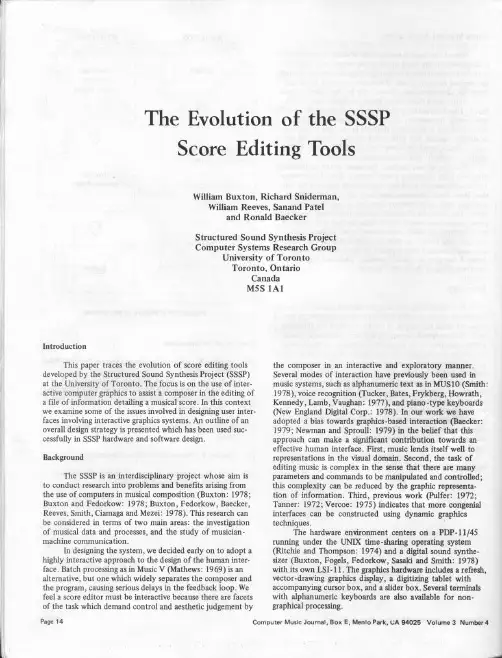
Rev Manag Sci(2010)4:53–90DOI10.1007/s11846-009-0037-2O R I G I N A L P A P E RWhy addingfirm value with a put feature in debt contracts is better than renegotiationChristian KoziolReceived:21January2009/Accepted:18November2009/Published online:6January2010ÓSpringer-Verlag2010Abstract In this paper,we analyze the ability of putable debt to addfirm value.To stress the impact of a put feature,we compare the resulting optimalfirm values and capital structures to those of afirm with straight debt that can be renegotiated.For this purpose,we consider a time-independentfirm value model with tax-deduct-ibility of coupon payments,bankruptcy costs in the case of a default,and dynamic restructuring.Wefind that a put right can always be designed so that a put is enforced for low asset values but the bond remains alive for high asset values.The optimalfirm value arising from this type of equilibrium strategy is remarkable for several reasons:The optimalfirm value under putable debt is always higher than under straight debt even under renegotiation with arbitrary negotiation power of debt and equity holders.Moreover,the optimalfirm value under putable debt always benefits from higher bankruptcy costs,while the optimalfirm value under straight debt suffers.Accordingly,a higher volatility of asset value returns can be favorable for a highfirm value under putable debt,while it always destroys value of afirm with straight debt.Keywords Tradeoff theoryÁPutable debtÁRenegotiationÁConsol bondÁContinuous-time modelJEL Classification C70ÁG13ÁG32This paper has strongly benefitted from very useful suggestions made by the editor Wolfgang Ku¨rsten as well as two anonymous referees.Moreover,I am thankful to the participants of DGF conference2006in Oestrich-Winkel,the Campus for Finance conference2007in Vallendar,and the Theory Workshop at the University of Mannheim.C.Koziol(&)University of Hohenheim,70593Stuttgart,Germanye-mail:c.koziol@uni-hohenheim.de54 C.Koziol 1IntroductionDebt is a crucial factor forfirms to addfirm value.The seminal papers by Fischer et al.(1989a)and Leland(1994)show howfirms have to choose their capital structure to accomplish their maximumfirm value.Thefirm value increase in their models comes from a tax advantage of coupons.The effect of coupon payments is that the taxable income on the corporate level declines,but the bondholders,who receive the coupons,suffer from an additional taxation.Since the tax reductions on the corporate level are usually higher than the additional taxes on the private level, there is an overall net tax reduction so that debt adds value.Even in the presence of bankruptcy costs,it is always optimal to lever afirm with debt and not to keep it unlevered as Leland(1994)shows.In the standard model by Leland(1994)with straight debt,the optimal capital structure results from a tradeoff between a potentially higher present value of tax benefits and a higher present value of bankruptcy costs associated with higher leverage.In general,a higher leverage in form of a higher coupon creates higher tax benefits as long as the coupon is paid and thefirm does not default.However,a higher coupon also results in an earlier default so that the tax benefits get lost earlier and the present value of bankruptcy costs increases.As a result,in order to have a highfirm value the design of debt contracts should be so that for a given coupon,a default is relatively unlikely or in other words the critical asset value(default barrier),at which a default occurs,is relatively low.The case of straight debt presented by Leland(1994)has the character of a benchmark model,because several authors introduce more sophisticated debt contracts to analyze its impact on thefirm value.A commonly regarded additional feature of debt is an issuer call right[see e.g.Fischer et al.(1989b),Leland(1998), Goldstein et al.(2001),Dangl and Zechner(2004),and Ross(2005)].A call right has two advantages.First,the default barrier for a contract with a given coupon is lower than without a call right.As mentioned above,the lower default barrier is a valuable factor to addfirm value as bankruptcy costs are reduced and tax benefits arise for a longer time.1Second,after a call thefirm can issue a further optimally designed bond(restructuring)which creates further value.Due to the dynamic restructuring,debt with a higher coupon is issued after every call date which results in further tax benefits and therefore increases thefirm value.A model framework in that a default and the associated bankruptcy costs can be avoided with certainty is presented by Fan and Sundaresan(2000)and in an extended version also by Christensen et al.(2002).The reason for why no bankruptcy costs arise is because thefirm can renegotiate the terms of the debt contract.2Once thefirm stops the coupon payments to enter into renegotiation,the debt holders will agree to swap their debt contract into an equity contract as Fan and Sundaresan(2000)show.The terms of the new claims result from Nash bargaining 1Koziol(2006)shows that for convertible debt,the default barrier rises through the conversion feature. Hence,convertible debt is usually less well-suited to addfirm value than callable debt.2Anderson and Sundaresan(1996)present the possibility of strategic debt service where only the current coupon payment is subject to renegotiation.See also Mella-Barral and Perraudin(1997)and Mella-Barral (1999)as further related examples for strategic debt service.Addingfirm value with a put feature in debt contracts55 between the debt and initial equity holders and primarily depend on the bargaining power of each counterparty.Since the outcome of the Nash bargaining game ensures that debt holders become equity holders,thefirm will be unlevered after renegotiation.Therefore,bankruptcy costs are successfully avoided so that thefirm value can be higher due to renegotiation.3A feature that has not been analyzed so far in terms of its ability to addfirm value is the put feature of debt.A put feature allows the bondholders to sell the bond at a pre-specified put price during its lifetime.Although putable bonds are not as widely-used as callable bonds,there is still a proportion of about5%among the outstanding corporate bonds in the US market that contains a put right.4Moreover,a put right usually arises in every bond and debt contract whenever thefirm violates a covenant.There are two ways to look at a put feature and its ability to addfirm value.From the discussion of the call feature in a debt contract,we know that a default becomes less likely as a call feature increases the equity value.Due to the higher equity value,thefirm has a higher incentive to avoid a default.Since the put right—in contrast to a call right—is an advantage for the debt holders,it is supposed to reduce the equity value which might speak for an earlier default.As long as a default of putable debt is possible,the default is supposed to take place earlier than without the put feature so that the put right reducesfirm value.However,we cannot be sure whether a default of putable debt will in fact take place.In particular,an equilibrium put strategy under which a put takes place before thefirm defaults seems to be highly attractive.Hence,the question is whether a design of putable bonds exists that ensures a put strategy without a default.Given that a suchlike bond design always exists,a further question is whether a put feature(without renegotiation)or a straight debt contract with renegotiation add morefirm value, because this put strategy exhibits parallels to that under renegotiation.In this paper,we analyze how a putable consol bond adds value to afirm and compare its outcome to the case with renegotiation.For this purpose,we consider a model framework with tax-deductibility of coupon payments and bankruptcy costs. In particular,we extend the Leland model by giving the bondholders the right to sell the bond to thefirm at the put price.In addition,we allow for a dynamic restructuring whenever the bondholders put their bond.To better see the effects caused by the put right,we abstract from other bond characteristics such as a call right and voluntary debt reductions.Suchlike features can be incorporated within our model in a straightforward way and might result in even higherfirm values.One aspect highly complicates the analysis,i.e.debt holders do not necessarily obtain the put price when putting the bond.However,depending on the asset value a put can force thefirm into default.Likewise,a default of thefirm does not necessarily take place once thefirm triggers a default.It is also possible that a stop 3Francois and Morellec(2004)extend the renegotiation idea of Fan and Sundaresan(2000)by introducing afinite time period in which renegotiation takes place.A further extension is from Euraslan (2008)and Annab and Francois(2007)who consider the more complex form of renegotiation with both senior and junior debt holders.4According to Bloomberg,81,212corporate bonds were outstanding in the US market by the end of October2005.Among those bonds,41,006bonds are callable and still3,607bonds are equipped with a put right.56 C.Koziol of the coupon payments enforces a put by the debt holders.Despite these ambiguous consequences of a default announcement by thefirm and a put by the debt holders,a bond design is always possible that results in a highly attractivefirm value.Under this bond design,the debt holders will wait with a put until thefirm announces a default.When shareholders optimally announce a default and debt holders put the bond,equity holders obtain the value of an alivefirm minus the put price.Since at the optimal default announcement date,this difference is positive,equity holders benefit from a put by the debt holders compared to a default where they get nothing. Since a put will occur at a relatively low barrier,the optimalfirm value with putable debt is remarkably high.In particular,putable debt results in higherfirm values than under straight debt with and without renegotiation.This is true for any arbitrary negotiation power of equity and debt holders.The rationale for the fact that a put feature results in higherfirm values than renegotiation is as follows.If afirm has debt with a given coupon outstanding,the equity holders want to renegotiate even for asset values for which a put cannot take place.Since thefirm value benefits from a lower put/renegotiation barrier,putable debt dominates debt under renegotiation.The optimal put strategy reveals further surprising properties.The optimalfirm value increases with the bankruptcy costs that would occur in the case of a default. Clearly,thisfinding is contrary to that for optimalfirm values with straight debt. The reason for this outcome is that under putable debt,bankruptcy costs are a disciplining device for the debt holders to accept a put once thefirm announces a default.Moreover,while under straight debt the optimalfirm value suffers from a higher volatility of asset value returns because a default becomes more likely,the optimal value of afirm with putable debt might increase.The remainder of the paper is as follows:Sect.2presents the model framework. The optimal default strategy and the optimalfirm value under the standard case of Leland(1994)with straight debt are described in Sect.3.Section4derives thefirm value under putable debt for an equilibrium strategy under that thefirm always remains solvent.The optimalfirm value under renegotiation based on Fan and Sundaresan(2000)is given in Sect.5.A comparison of the optimalfirm values and the corresponding debt structures under straight debt,renegotiation,and putable debt is in Sect.6.Section7provides a comparative static analysis of the optimal firm values under straight debt,renegotiation,and putable debt.Section8concludes. Technical derivations are in Appendix2.2Model frameworkTo analyze in how far a put feature in a debt contract adds value to afirm,we extend the time-independentfirm value model presented by Leland(1994)for straight debt contracts by regarding debt with a put feature and accounting for dynamic restructuring.A major part of the analysis will be to compare the optimalfirm value with putable debt to the values of otherwise identicalfirms with optimally-designed straight debt with and without renegotiation.The standard case with straight debt is by Leland(1994),while Fan and Sundaresan(2000)provide an extension with renegotiation.To have a consistent setup with both of these model frameworks,weAddingfirm value with a put feature in debt contracts57 also regard the asset value of thefirm as state variable.5This allows us to compare the outcome for putable debt with the well-known results from Leland for straight debt and Fan/Sundaresan under renegotiation by using the same notation in an arbitrage-free framework.We consider an entrepreneur who is endowed with initial assets having a value equal to V0at time t=0.At this point in time,the entrepreneur has the possibility to issue a debt contract to new investors.The advantage of issuing a debt contract is that coupon payments are tax deductible on the corporate level.A tax advantage from coupon payments always arises if the tax rate of thefirm exceeds the tax rate an investor has to pay for receiving the coupon payments.To keep the notation simple,we denote s with 0\s\1as the corporate tax rate and consider tax exempt bondholders.This means that if thefirm pays a coupon equal to C to the debt holders,thefirm reduces its taxable base by this amount.Under the assumption that the same tax rate applies to positive and negative taxable income,the net payment resulting from the debt obligation is only CÁ(1-s)rather than C.Coupon obligations,however,can also have a drawback which is in effect if the firm is not able or does not want to fulfil the promised coupon obligations and defaults.In this case,bankruptcy costs a(0\a\1)proportional to the asset value V t at this time arise.To satisfy the coupon payments,thefirm requires an externalfinancing as we assume that parts of the assets of thefirm cannot be sold.Thisfinancing is covered by equity holders.Moreover,we consider dividend payments of thefirm.In each dividend date,the firm pays a dividend proportional to the asset value V t with a rate bÁV t.This dividend payment goes on a pro rata basis to the equity holders.Since the analysis takes place in a time-continuous setting,we have coupon and dividend dates in each instant of time.To be precise,from now on C denotes the coupon rate.Therefore,the size of the payout ratio b,the asset value V t,and the coupon C decide whether the instantaneous net payoff(bÁV t-CÁ(1-s))dt to the equity holders is positive or negative.A putable consol bond pays a promised coupon rate C until the debt holders put or thefirm defaults.With a put the bondholders receive the put price PP if thefirm is still solvent.Otherwise,if thefirm is not willing to pay the put price,thefirm defaults.The payment of the put price isfinanced by capital injections through the5Goldstein et al.(2001)provide an extensive discussion about advantages and disadvantages of the asset value models compared to models using thefirm’s free cashflows before interest and tax payments as state variable.However,there is still a major advantage of the asset value models.The advantage is that e.g.a low dividend can be associated with a highfirm value and vice versa.In the case of the models with instantaneous cashflow as the state variable,the dividend is endogenous.Therefore,a high instantaneous free cashflow,which is related to a highfirm value,results in a high dividend payment.This is the reason why very successfulfirms that mostly reinvest their free cashflows rather than to pay a dividend can hardly be captured by the cashflow models.To understand the equilibrium put strategies,it will be important to allow for aflexible choice of the payout rate which is accomplished by the asset value models.Moreover,both models do not allow for arbitrage opportunities as we will see further below. Ross(2005)illustrates the close relation of the cashflow models to the asset value models by showing how to derive the free cashflow process from the asset value process.equity holders in the same way as the coupon payments.After a put the debt is no longer alive.Since a put without a default results in an unleveredfirm,there is a potential for afirm value increase by issuing a further bond.To capture the potential firm value increase,we account for a restructuring after a put.A restructuring requires costs k proportional to the asset value V t at the restructuring date.At this point we assume that primarily the size of thefirm determines the restructuring costs.In particular,other assumptions e.g.that restructuring costs arefixed or proportional to the coupon are also possible and the results remain valid.The asset value V t is assumed to follow a geometric Brownian motion,where the current asset value V as well as the instantaneous expected return l and the standard deviation r of the asset value return are commonly known:dV¼lÁVdtþrÁVdW;where dW denotes the increment of a standard Wiener process.Thefinancial claims such as(putable)debt and equity are traded on frictionless and arbitrage-free capital markets where market participants are risk neutral.6 Hence,the values of equity S and debt D,given that they are still alive,must satisfy the following set of differential equations:1 2r2Áo2So VþrÀbðÞÁVÁo So VÀrÁSþbÁVÀCÁð1ÀsÞ¼0;12r2Áo2Do VþrÀbðÞÁVÁo Do VÀrÁDþC¼0;ð1Þwhere r[0is the time-constant interest rate for all maturities.These differential equations will allow us to determine the values of equity and the corresponding debt contracts in the following sections.In this setup,there are three levels of optimal decision making:First,the entrepreneur optimally determines the debt contract so that thefirm value is maximized.Thefirm value rather than the equity value is maximized since the entrepreneur wants to maximize his or her wealth.The wealth consists of the value of issued debt and equity.Hence,thefirm value,which is the sum of the equity and the debt value,is the objective function of the entrepreneur(and equivalently the objective function of thefirm).At this point,we stress that thefirm value can be different from the asset value V t.Second,after a bond contract has been sold,thefirm follows a strategy in favor of the equity holders,i.e.thefirm desires to maximize the equity value rather than the totalfirm value.This strategy implies that the equity holders(or equivalently the firm)decide whether or not to inject money into thefirm(or to raise outside capital) for coupon payments and if necessary for the payment of the put price.Since this decision is made by thefirm in favor of the equity holders,we will also use the term 6The assumption that investors are risk-neutral implies l=r and is no restriction from the more general case with investors requiring an arbitrary risk premium l=r.Given a non-zero risk premium,we can still consider the process of the asset value with a drift equal to r rather than l.In this case,the process refers to the(for pricing purposes relevant)risk-neutral measure rather than the true probability measure.58 C.Koziolthat the equity holders (or equivalently the firm)default to indicate that this decision is made in their interest.Third,the debt holders,which hold a put right,must continuously determine the optimal put strategy that maximizes the debt value.At this point,we can intensively debate whether a Leland-type model captures the major economic implications or whether it is a too strong restriction from real world.At first glance,the observation,that equity holders continuously have to inject capital to keep the firm alive,once the generated cash is not sufficient to cover the coupon obligations,seems to be a strong difference from real world financing situations.In particular,there are two concerns:the first one refers to the continuity of the cash injections and the second one deals with the financing policy of the firm.From an economic perspective,it is,however,not a substantial difference whether cash is injected continuously or at few discrete days—given there are no issuing costs.Therefore,we can alternatively understand the Leland world as an environment in which firms raise (continuously or at discrete dates)external capital to prevent a default.Since external capital can only be raised,whenever this is a worthwhile (equity)investment for new investors,the default concept builds upon a plausible economic setting which is driven by the ability to find new investors.3Straight debtIn this section,we repeat the standard case of a firm with straight debt which was also presented by Leland (1994).The purpose of this analysis is to provide a benchmark for optimal values of firms with putable debt which will be derived later.3.1Analysis of an arbitrary straight debt contractTo analyze the case of an arbitrary straight debt contract,we assume that the firm has a consol bond with a coupon C outstanding.The firm can decide how long to pay the coupon.If the asset value V hits the critical default barrier V B ,the firm stops paying the coupon or alternatively the equity holders are no longer willing to inject money into the firm.At the default barrier V B ,the following values for equity and debt arise:lim V !V BS ðV ;V B Þ¼0;lim V !V B D ðV ;V B Þ¼1Àa ðÞÁV B :These relations formally indicate that in the case of a default the equity holders are left with nothing and the debt holders obtain the asset value (1-a )ÁV after pro-portional bankruptcy costs a .In the case that the asset value becomes sufficiently high,the danger of a default diminishes.Therefore,the debt value equals the value C r of a default-free consol bond and the equity value is equal to the tax advantage C r s arising from this bond:Adding firm value with a put feature in debt contracts 59lim V !1S ðV ;V B Þ¼V ÀC rÁð1Às Þ;lim V !1D ðV ;V B Þ¼C r :ð2ÞWith these conditions,the values of equity and straight debt for a given default strategy V B with V [V B can be obtained from (1)asS ðV ;V B Þ¼V ÀC r ð1Às ÞþV V B Y ÁÀV B þC r ð1Às Þ ;D V ;V B ðÞ¼C r þV V B Y Áð1Àa ÞÁV B ÀC r;ð3ÞwhereY ¼1Àffiffiffiffiffiffiffiffiffiffiffiffiffiffiffiffiffiffiffiffiffiffiffiffiffiffiffiffiffiffiffiffiffiffiffiffiffi4Ár Àb ðÞ2þ4Ár þb ðÞÁr 2þr 4p r 22Àr Àb r 2:It will be helpful to see that Y is always negative.The optimal default barrier V B *follows from the firm’s objective to maximize the equity value or in other words the coupon is paid as long as the required capital injections are worthwhile for the equity holders:V ÃB ¼arg max V BS ðV ;V B ÞUnder the optimal choice of the default barrier,the smooth-pasting condition must be valid:o S V ;V ÃB ÀÁo V V ¼V ÃB¼0Solving for V B *yieldsV ÃB ¼C r ð1Às ÞÀY 1ÀY :ð4ÞSince Y is always negative,the default barrier V B *is a finite positive number.Hence,we always have a region with asset values V B V B *for which the firm defaults,and a region with the remaining asset values V [V B *for which the firm is alive and fulfills its coupon obligation.3.2Optimal firm value under straight debtIn the case of straight debt,the optimal characteristics of debt only concern the size of the coupon.A higher coupon creates higher tax benefits if the firm remains alive.However,with an increase of the coupon,the likelihood of a default,which is associated with a loss of future tax benefits,rises.A further disadvantage of a higher coupon is that a default takes place at a higher asset value V B *which results in higher bankruptcy costs a ÁV B *in the case of default and a default is more likely.60 C.KoziolThis tradeoff between tax and bankruptcy effects is revealed by the representation of the firm value v ðC Þ¼S V ;V ÃB ÀÁþD V ;V ÃB ÀÁ¼V þ1ÀV ÃB Y !ÁC s ÀV ÃBY Áa ÁV ÃB ;where the default barrier is chosen according to Eq.(4).The optimal coupon size C *formally results from the first order conditiono v ðC Þo C ¼s ÀV V ÃB Y Ás ÀY Áa þð1Àa ÞÁs ðÞðÞr¼0and simplifies toC üV Ár 1Às 1ÀY ÀY s ÀY Áa Áð1Às Þþs ðÞs1=Y :Since the second derivativeo 2v ðC Þo C 2¼Y C Ár V V ÃBY Ás ÀY Áa þð1Àa ÞÁs ðÞðÞis always negative due to Y \0,the local optimum C *is the global maximum.As C *is always positive,a positive amount of debt can always be issued so that the firm value v (C )is higher than that of an unlevered firm whenever the tax rate s is positive.In order to distinguish between the optimal coupon of a firm with straight debt from firms with other types of bonds,we will also use the notation C plain to refer to the optimal coupon under straight debt where necessary.Accordingly,V B plain stands for the optimal default barrier of a firm with straight debt and v plain (C plain )for the optimal firm value.4Putable debt4.1Pricing of an arbitrary putable debt contract for a given strategyIn this subsection,we consider a firm that has a putable consol bond outstanding with coupon C and put price PP .The firm can follow the default strategy V B and the debt holders decide at which critical asset value V P to put their debt.Strictly speaking,the default strategy V B indicates at which barrier the firm announces a default given that debt holders have not put before.Accordingly V P is the barrier at which the debt holders put the debt given that the firm has not announced a default before.At this point it is important to note that after an announcement of a default by the firm,the debt holders can still respond with a put.Accordingly,the firm can decide whether to default or not after a put.Adding firm value with a put feature in debt contracts 6162 C.KoziolWhen analyzing putable debt,we will disregard the possibility of renegotiation throughout the whole paper.An additional possibility of renegotiation might imply that the equity holders want to renegotiate the debt characteristics before a put might have taken place.In those cases,the outcome is analogous to the case with renegotiation presented in Sect.5.By doing so,we follow a similar approach as the seminal papers by Fischer et al.(1989)and Goldstein et al.(2001)where in order to focus on the call feature in the debt contract renegotiations are ruled out.Moreover, Aghion et al.(1994)explain that mechanisms exist to effectively prevent a renegotiation.In particular,there are various cases such as for widely held bonds in which it is practically impossible to carry out any renegotiations.Figure1shows the decision process after a default announcement.If the asset value hits a default barrier V B and the debt holders do not put,a default occurs and the equity and debt values are as for a straight debt contract.However,if thefirm announces a default,V=V B,the debt holders still have the right to put the debt.A put is optimal for the debt holders if the default value(1-a)ÁV B is below the put price PP.After an announcement of a default and the succeeding put,equity holders can decide whether they still want to default or whether they want to keep thefirm alive by paying the put price PP to the debt holders.For the equity holders it is optimal to prevent a default and to pay the put price if and only if thefirm value (after the gains from a potential restructuring)minus the put price is non-negative. This is because if the equity holders save thefirm by paying the put price PP,they obtain an unleveredfirm with asset value V.This unleveredfirm value can potentially be further increased by a restructuring.We account for the restructuring option by a factor m opt C1that increases the asset value V to thefirm value m optÁV. We will show later how to determine the endogenous asset value multiplier m opt. We note that bankruptcy costs only occur,if the ownership of thefirm changes.A default announcement to enforce a put is equivalent to stopping the coupon payments which must take place before afirm enters into renegotiation in the model by Fan/Sundaresan.Since both a default announcement that results in a payment of the put price as well as a successful renegotiation of the debt contract do not result in a default and therefore do not change the ownership structure of the equity of the firm,there are no bankruptcy costs involved.7We will present the case of renegotiation in Sect.5.As a consequence of the strategic options of thefirm and the debt holders we see that thefirm can force the debt holders to an immediate put by a default announcement whenever the current default value(1-a)ÁV is below the put price PP.This gives the following conditions for the equity value S(V,V B,V P)and debt value D(V,V B,V P)depending on the default barrier V B followed by thefirm and the put barrier V P chosen by the debt holders.If V hits a default barrier V B,it holds 7At this point one can introduce costs associated with a default announcement in a straightforward way. Section7shows that putable debt is still an attractive debt contract even if there are extremely high (restructuring)costs involved.Moreover,the key relationship that putable debt results in a higherfirm value than under renegotiation will be still valid.。
Passage01 冰箱Q: 请问第一篇冰箱的发明的第2和3空怎么定位,我在原文找不到。
A: 第二第三题对应正文第四段最后一句话。
原文:and another made by physician JG, and developed vapor-compression refrigeration for the brewing and meatpacking industries.题干:and commercial refrigeration was applied to______as well as_______industries.对应:for=applied to; and=as well as定位词:commercial refrigerationQ: 还是冰箱那篇,为什么第5个空不能填alternatives?在原文中不是刚好接在比较级better后面吗?A: 第五题对应正文第五段第三句话。
原文:engineers worked until the 1920s to come up with better alternatives, one of which was Freon.题干:The safer _________took over it in 1920s.对应:better=safer; come up with=took over定位词:1920s请注意,填alternative不是最优答案,最准确的是氟利昂FreonPassage02 阿尔弗雷德诺贝尔Q: 求问第二篇第三题写highly explosive行不行?第二篇第三提求解析填的consideredA: 第三题对应正文第三段倒数第三行:he also realised that the safety problems had to be solved对应原文译文:阿尔弗雷德.诺贝尔对硝化甘油以及如何将它投入到建工领域进行实用非常有兴趣。